I've put together a montage of the different chants over the course of the evening.
Yeah, we're a bunch of hippies. A bunch of pissed off, angry hippies. (Wanna make something of it?)
But we also represent a lot of pissed off non-hippies all across the country. We're speaking out for "average citizens" across the U.S. everywhere.
Note that I've made an uncompressed AIFF file of this available for sampling purposes.
SF Chant Montage (Small - 5 MB)
SF Chant Montage (Hi-Res - 52 MB)
Audio - SF Chant Montage (MP3 - 2 MB)
Audio - SF Chant Montage (Uncompressed AIFF - 10 MB)
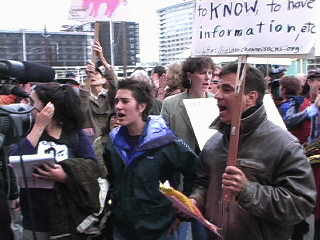
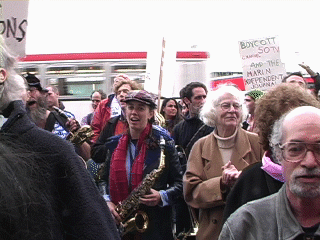
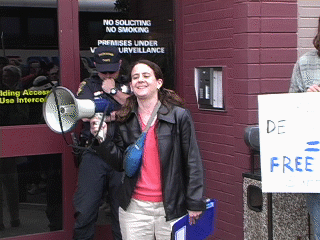

This work is dedicated to the
Public Domain. (Take it and run, baby!)
This is the first in a number of installments of the video and audio from yesterday's protest last night at 340 Townsend Street in front of the Clear Channel offices.
(Note: I've just added a montage of chants here.)
I'll be providing "highlight" versions of everything as well as complete versions of everything I post.
The one thing that stood out to me was the point people kept making that Clear Channel is already abusing existing regulations. Why on earth would the FCC ever relax them further when Clear Channel doesn't even respect them now?
So the problem is not only what could happen if these rules are further relaxed. The problem exists now, with the rules the way they are. Clear Channel owns nine stations in the SF Bay Area market, for example, while the legal limit is eight.
Note: As of 10 AM PST, the high resolution versions of this stuff were still uploading.
I'd give it another half hour or so at least.
Andrea Buffa, Global Exchange - Highlights Reel 1
Andrea Buffa - Highlights Reel 1 (Small - 8 MB)
Andrea Buffa - Highlights Reel 1 (Hi-Res - 64 MB)
Audio - Andrea Buffa - Highlights Reel 1 (MP3 - 2 MB)
Andrea Buffa, Global Exchange - Complete Part 1
Andrea Buffa - Part 1 (Small - 10 MB)
Andrea Buffa - Part 1 (Hi-Res - 125 MB)
Audio - Andrea Buffa - Part 1 (MP3 - 4 MB)
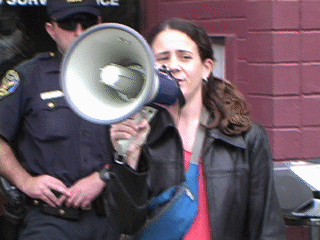

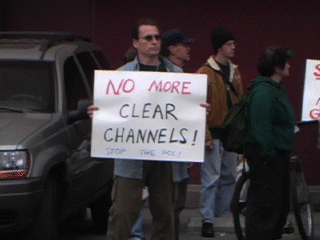
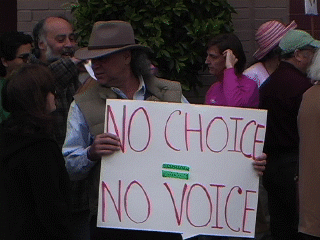

This work is dedicated to the
Public Domain. (Take it and run, baby!)
Justice Takes a Beating
In The Los Angeles Times.
This is the full text of the article. It's all too important to leave any out.
While Supreme Court Justice Clarence Thomas labored to justify the bullying interrogation of a farm worker whom an Oxnard police officer had just gravely wounded, Justice John Paul Stevens, dissenting, called the inquisition what it was: "the functional equivalent" of torture. Thomas' 6-3 majority opinion Tuesday rolls back decades of constitutional protections against self-incrimination and all but invites the backroom rough-'em-up police tactics of old.The farm worker, Oliverio Martinez, is blind and partly paralyzed from the five bullets that police pumped into his body after they stopped him in connection with an investigation of possible drug sales in his Oxnard neighborhood. Although Martinez initially complied with orders to dismount from his bicycle, a scuffle resulted when the officers discovered he was carrying a knife and Martinez was shot.
Paramedics arrived and carted away Martinez, bleeding and screaming, to a hospital. For nearly an hour, as Martinez waited for medical treatment and then as doctors tended him, the officers pressured him to confess to starting the fight.
"I am dying!" Martinez cried.
"OK, yes, you are dying," the officer said. "But tell me why you are fighting with the police."
Not once did the police officers inform Martinez of his right to remain silent and to have a lawyer present. Instead, to try to badger him into a confession, they took advantage of his physical agony and mental anguish and the fact that he couldn't move from the hospital bed.
In the end, the officers got nothing useful from Martinez and never charged him with a crime. Martinez sued, both for the shooting and for civil damages on the ground that police violated his 5th Amendment right against self-incrimination and his due process rights against egregious police conduct. The shooting lawsuit still stands.
Writing for a splintered majority, Thomas insisted that where there was no harm of any legal consequence, there was no foul. "Martinez was never made to be a 'witness' against himself in violation of the 5th Amendment's self-incrimination clause because his statements were never admitted as testimony against him in a criminal case [T]he mere use of compulsive questioning, without more, [does not] violate the Constitution." Such a narrow thread of reasoning cuts a wide path to cruelty.
Because Martinez had not been advised of his rights, the court said, had police charged him based on his nearly incoherent statements, his disclosures would not have been admissible as evidence anyway.
Three cases before the court next term could push at the boundaries of permissible evidence in criminal cases. The Martinez case turns back the clock, and the coming cases could multiply the harm to a civilized justice system.
The Supreme Court has ruled that it's okay to beat up suspects without reading them their miranda rights in order to get statements out of them, even if those statements will most likely be thrown out later in a court of law. (Or not get thrown out, of course, considering that such decisions will be made later by individual judges on a case by case basis.)
Clarence Thomas, who wrote the opinion, said that this is true even in the extreme case of Oliverio Martinez, who was in a hospital, bleeding to death from police-inflicted bullet wounds during the interrogation in question.
Here's a link to the opinion and concurring and dissenting opinions: CHAVEZ V. MARTINEZ.
Court Finds Coercive Questioning OK
Justices say defendants or suspects can be compelled to respond to police questioning, even though the statements may not be used against them in court
By James Gerstenzang for The Los Angeles
The Supreme Court ruled today that coercive questioning of a suspect by police officers -- even a gravely wounded man who has not been offered his Miranda rights -- does not violate a person's Constitutional rights, as long as the questioning stops short of torture.The court said defendants have the right not to have statements they make to police used in court against them during trial. But defendants or suspects can still be compelled to respond to police questioning.
The 6-to-3 decision is likely to have wide ramifications because it could open the door to increased pressure by police officers interrogating potential defendants...
Writing for the majority, Justice Clarence Thomas said that while a person under police questioning has the right not to answer questions where the answer might be self-incriminating in future criminal proceedings, "that does not alter our conclusion that a violation of the constitutional right against self-incrimination occurs only if one has been compelled to be a witness against himself in a criminal case."
Thomas wrote: "Mere coercion does not violate the text of the self-incrimination clause absent use of the compelled statements in a criminal case against the witness."
The farm worker, Oliverio Martinez, was questioned in a hospital emergency room after he had been shot five times by police. He had not been told of his rights to remain silent, or to have a lawyer's assistance, and he has maintained that a police sergeant questioned him after he said he did not want the questioning to continue.
Here is the full text of the article in case the link goes bad:
http://www.latimes.com/news/nationworld/nation/la-052703scotus_lat,1,4093479.story?coll=la%2Dhome%2Dheadlines
Court Finds Coercive Questioning OK
By James Gerstenzang
The Los Angeles
Tuesday 27 May 2003
Justices say defendants or suspects can be compelled to respond to police questioning, even though the statements may not be used against them in court
WASHINGTON -- The Supreme Court ruled today that coercive questioning of a suspect by police officers -- even a gravely wounded man who has not been offered his Miranda rights -- does not violate a person's Constitutional rights, as long as the questioning stops short of torture.
The court said defendants have the right not to have statements they make to police used in court against them during trial. But defendants or suspects can still be compelled to respond to police questioning.
The 6-to-3 decision is likely to have wide ramifications because it could open the door to increased pressure by police officers interrogating potential defendants.
At issue is the extent of the protections provided by the Fifth Amendment against self-incrimination, the 1966 Miranda decision guaranteeing a person's right to remain silent in the face of police questioning and the right to obtain a lawyer before being interrogated.
In the decision, however, the high court ruled that suspects have a right to sue if they are tortured during police questioning.
In another Supreme Court case today, the court upheld the rights of state workers under a federal law guaranteeing time off to care for children or ailing relatives, departing from the court's line of cases that expand state rights at the expense of federal power or laws passed by Congress.
The court, in the decision written by Chief Justice William H. Rehnquist, held that state employees can sue in federal court to enforce their rights under the Family and Medical Leave Act.
The Mirada ruling decision occurred in the 1997 case of an Oxnard, Calif., farm worker who was arrested and shot multiple times by police who then questioned him -- despite his protestations -- as he lay gravely wounded.
Writing for the majority, Justice Clarence Thomas said that while a person under police questioning has the right not to answer questions where the answer might be self-incriminating in future criminal proceedings, "that does not alter our conclusion that a violation of the constitutional right against self-incrimination occurs only if one has been compelled to be a witness against himself in a criminal case."
Thomas wrote: "Mere coercion does not violate the text of the self-incrimination clause absent use of the compelled statements in a criminal case against the witness."
The farm worker, Oliverio Martinez, was questioned in a hospital emergency room after he had been shot five times by police. He had not been told of his rights to remain silent, or to have a lawyer's assistance, and he has maintained that a police sergeant questioned him after he said he did not want the questioning to continue.
The police supervisor pressed him to explain his version of the events leading to the shooting.
In a transcript of the interview, Martinez is said to have responded: "I am choking. I am dying, please."
The officer said: "If you are going to die, tell me what happened."
Martinez was not charged with a crime; the violence left him blind and paralyzed and he sued the police sergeant and the City of Oxnard for, among other things, coercive questioning.
In its defense, the Oxnard police department asserted that the Miranda ruling does not include a "constitutional right to be free of coercive interrogation," but only a right not to have forced confessions used at trial. The Bush administration sided with the police in the case.
Writing for the minority, Justice John Paul Stevens said the interrogation was akin to "an attempt to obtain an involuntary confession from a prisoner by torturous methods."
The Shrub Administration is "floating" its plans to convert Guantanamo Bay into a 'Death Camp,' where prisoners are sentenced to death and executed, without ever being given a chance to defend themselves, on a regular basis.
Experts say that this has always been the plan.
I'm not sure what we can do about this yet guys, but be assured that it's on the radar and I'll be letting you know what action we can take to oppose this over the days and weeks to come.
US plans death camp
In the Courier Mail.
THE US has floated plans to turn Guantanamo Bay into a death camp, with its own death row and execution chamber.Prisoners would be tried, convicted and executed without leaving its boundaries, without a jury and without right of appeal, The Mail on Sunday newspaper reported yesterday.
The plans were revealed by Major-General Geoffrey Miller, who is in charge of 680 suspects from 43 countries, including two Australians.
The suspects have been held at Camp Delta on Cuba without charge for 18 months.
General Miller said building a death row was one plan. Another was to have a permanent jail, with possibly an execution chamber.
The Mail on Sunday reported the move is seen as logical by the US, which has been attacked worldwide for breaching the Geneva Convention on prisoners of war since it established the camp at a naval base to hold alleged terrorists from Afghanistan.
But it has horrified human rights groups and lawyers representing detainees...
American law professor Jonathan Turley, who has led US civil rights group protests against the military tribunals planned to hear cases at Guantanamo Bay, said: "It is not surprising the authorities are building a death row because they have said they plan to try capital cases before these tribunals.
"This camp was created to execute people. The administration has no interest in long-term prison sentences for people it regards as hard-core terrorists."
Here is the full text of the article in case the link goes bad:
http://www.thecouriermail.news.com.au/common/story_page/0,5936,6494000%255E401,00.html
US plans death camp
26may03
THE US has floated plans to turn Guantanamo Bay into a death camp, with its own death row and execution chamber.
Prisoners would be tried, convicted and executed without leaving its boundaries, without a jury and without right of appeal, The Mail on Sunday newspaper reported yesterday.
The plans were revealed by Major-General Geoffrey Miller, who is in charge of 680 suspects from 43 countries, including two Australians.
The suspects have been held at Camp Delta on Cuba without charge for 18 months.
General Miller said building a death row was one plan. Another was to have a permanent jail, with possibly an execution chamber.
The Mail on Sunday reported the move is seen as logical by the US, which has been attacked worldwide for breaching the Geneva Convention on prisoners of war since it established the camp at a naval base to hold alleged terrorists from Afghanistan.
But it has horrified human rights groups and lawyers representing detainees.
They see it as the clearest indication America has no intention of falling in line with internationally recognised justice.
The US has already said detainees would be tried by tribunals, without juries or appeals to a higher court. Detainees will be allowed only US lawyers.
British activist Stephen Jakobi, of Fair Trials Abroad, said: "The US is kicking and screaming against any pressure to conform with British or any other kind of international justice."
American law professor Jonathan Turley, who has led US civil rights group protests against the military tribunals planned to hear cases at Guantanamo Bay, said: "It is not surprising the authorities are building a death row because they have said they plan to try capital cases before these tribunals.
"This camp was created to execute people. The administration has no interest in long-term prison sentences for people it regards as hard-core terrorists."
Britain admitted it had been kept in the dark about the plans.
A Downing St spokesman said: "The US Government is well aware of the British Government's position on the death penalty."
This one comes right on schedule, unfortunately. Soldiers are starting to notice symptoms of "vaccine overload." Such symptoms are similar to that of Gulf War Syndrome.
'War vaccines poisoned us'
By Rebecca Mowling for the Evening Standard.
Four British soldiers who received jabs for the Iraq conflict are to sue the Ministry of Defence claiming they are suffering from a new form of Gulf War Syndrome.The revelation comes as a veterans' support group predicted today that thousands of UK servicemen will come forward with mystery illnesses linked to "vaccine overload".
Tony Flint of the National Gulf Veterans and Families' Association, confirmed he now anticipates a fresh wave of health cases. "We are expecting at least 6,000 new cases as a result of the Iraq conflict - about 30 per cent of the 22,000 troops who had the anthrax vaccination."
Danger zone: Several troops claim vaccinations made them ill
The first four soldiers from the latest conflict who are set to sue - two reservists and two regulars - are blaming depression, breathing problems and eczema on injections they were given before being sent to the Middle East.
Professor Malcolm Hooper, chief scientific adviser to the veterans' association, said the MoD did not seem to have learned from "the mistakes of the 1991 conflict" in relation to multiple vaccinations. "These guys are clearly suffering from vaccine overload," he said.
The key concern centres on soldiers given anthrax vaccines on top of other more routine inoculations.
Professor Hooper added: "The problem was one which was there in 1991. Our studies have shown that these people have excessive symptoms - three to four-fold compared with people who have not been vaccinated in the same way."
...Lawyer Mark McGhee, who is acting for the four men, said: "The symptoms that these four individuals are experiencing are identical to those of the individuals I represent in relation to the first Gulf war." The High Court is due to rule within weeks on whether Gulf War Syndrome can be recognised in law.
Here is the full text of the article in case the link goes bad:
http://www.thisislondon.com/news/articles/5000823?source=Evening%20Standard
'War vaccines poisoned us'
By Rebecca Mowling, Evening Standard
27 May 2003
Four British soldiers who received jabs for the Iraq conflict are to sue the Ministry of Defence claiming they are suffering from a new form of Gulf War Syndrome.
The revelation comes as a veterans' support group predicted today that thousands of UK servicemen will come forward with mystery illnesses linked to "vaccine overload".
Tony Flint of the National Gulf Veterans and Families' Association, confirmed he now anticipates a fresh wave of health cases. "We are expecting at least 6,000 new cases as a result of the Iraq conflict - about 30 per cent of the 22,000 troops who had the anthrax vaccination."
Danger zone: Several troops claim vaccinations made them ill
The first four soldiers from the latest conflict who are set to sue - two reservists and two regulars - are blaming depression, breathing problems and eczema on injections they were given before being sent to the Middle East.
Professor Malcolm Hooper, chief scientific adviser to the veterans' association, said the MoD did not seem to have learned from "the mistakes of the 1991 conflict" in relation to multiple vaccinations. "These guys are clearly suffering from vaccine overload," he said.
The key concern centres on soldiers given anthrax vaccines on top of other more routine inoculations.
Professor Hooper added: "The problem was one which was there in 1991. Our studies have shown that these people have excessive symptoms - three to four-fold compared with people who have not been vaccinated in the same way."
Concern about the long-term side-effects led to almost half the 45,000 British servicemen and women in the recent conf lict refusing vaccinations against anthrax, fearing that they might be afflicted by the syndrome. However, all four men are understood to have been given the anthrax vaccination and had multiple jabs in one day before falling ill.
Royal Engineers reservist Stephen Cartwright was taken to hospital with a fever and blistered skin after being given a number of jabs, including the controversial anthrax vaccine. The 24-yearold spent four days in hospital and was so ill he did not make it to the Gulf.
The second reservist, Tony Barker, 45, was given five vaccinations - hepatitis, typhoid, polio, diphtheria and yellow fever on 17 February, days after he was called up. The father-of-one received an anthrax jab less than a week later. The Royal Logistics Corps driver fell ill in Kuwait after being given nerve agent pre-treatment and anti-malarial pills. He also had a second anthrax jab on 13 March.
Lawyer Mark McGhee, who is acting for the four men, said: "The symptoms that these four individuals are experiencing are identical to those of the individuals I represent in relation to the first Gulf war." The High Court is due to rule within weeks on whether Gulf War Syndrome can be recognised in law.
But the MoD has also accepted that some troops returning from the latest conflict may suffer long-term health problems as a result of the war and has begun a screening programme.
Iran-Contra Figure Plays Key Role on Mideast
By Michael Dobbs For The Washington Post.
A cycle of disgrace and redemption has brought one of Washington's most accomplished -- and controversial -- bureaucratic infighters back to the center of U.S. foreign policy decision-making.When Elliott Abrams stood in front of a federal judge in October 1991 and pleaded guilty to two misdemeanor counts of withholding information from Congress, few imagined he would ever return to government. At age 43, he had become one of the casualties of the Iran-contra scandal, detested by Democrats for his combative political style and mistrusted by human rights activists for playing down the crimes of right-wing dictatorships in Central America.
Twelve years later, Abrams is helping to shape White House policies toward many of the world's trouble spots. Appointed in December as President Bush's senior adviser on the Middle East, his responsibilities extend from Algeria to Iran. But nowhere is his influence more evident than on the Arab-Israeli peace process...
Here is the full text of the article in case the link goes bad:
http://www.washingtonpost.com/wp-dyn/articles/A41843-2003May26.html?nav=hptop_tb
Back in Political Forefront
By Michael Dobbs
The Washington Post
Tuesday 27 May 2003
Iran-Contra Figure Plays Key Role on Mideast
A cycle of disgrace and redemption has brought one of Washington's most accomplished -- and controversial -- bureaucratic infighters back to the center of U.S. foreign policy decision-making.
When Elliott Abrams stood in front of a federal judge in October 1991 and pleaded guilty to two misdemeanor counts of withholding information from Congress, few imagined he would ever return to government. At age 43, he had become one of the casualties of the Iran-contra scandal, detested by Democrats for his combative political style and mistrusted by human rights activists for playing down the crimes of right-wing dictatorships in Central America.
Twelve years later, Abrams is helping to shape White House policies toward many of the world's trouble spots. Appointed in December as President Bush's senior adviser on the Middle East, his responsibilities extend from Algeria to Iran. But nowhere is his influence more evident than on the Arab-Israeli peace process.
A self-described "neo-conservative and neo-Reaganite" with strong ties to Jews and evangelical Christians, Abrams has become a flash point for the debate on how much pressure the Bush administration is prepared to apply to Israeli Prime Minister Ariel Sharon to reach an agreement with the Palestinians. Last week, the White House sought to address Israeli concerns about a U.S.-endorsed "road map" on Israeli-Palestinian peace by saying they would be considered during the implementation phase.
The question for many critics, both inside and outside government, is whether the White House will risk a public fight with Sharon on freezing and eventually reversing Jewish settlement activity that could antagonize some of its core political supporters in the run-up to a presidential election. Before joining the Bush administration, Abrams expressed skepticism about past U.S. peacemaking efforts in the region and praised Sharon for his "strength" and "firmness" toward the Palestinians in contrast to the "weakness" displayed by his predecessor, Ehud Barak.
Abrams's supporters emphasize his formidable bureaucratic skills, and say his pro-Sharon views will provide political cover for the administration in extracting concessions from a reluctant Israeli government. His enemies depict him as a partisan, ideological figure who pays a lot of attention to the pro-Israel lobby, but has yet to reach out to Arab Americans. Abrams's appointment raised a "red flag for me and my community," said Khalil Jahshan, director of government affairs for the Arab-American Anti-Discrimination Committee. "If the president is serious about a two-state solution to the Israeli-Palestinian conflict, he picked the wrong person to manage the policy for him."
"Much of the criticism of Elliott misses the fact that he is an extremely intelligent, competent guy," countered William Kristol, a conservative commentator who served alongside Abrams in the Reagan administration. "Bush is more committed to seeing whether he can push ahead with the Middle East peace process than most people believe, and that is true of Elliott as well."
Unlike his previous incarnation in government, when he was a high-profile figure on Capitol Hill and in the media, Abrams this time around is working far from the glare of publicity and congressional oversight. According to people who have dealt with him, however, his operating style has changed little in the intervening decade, and is characterized by the same combination of ideological zeal and bureaucratic toughness that made him a formidable advocate for the Reagan administration.
"He is relentless in pursuit of his agenda," said someone who has clashed with him in internal administration debates. "If that means pushing people out of the way who disagree with him, then that is what he will do."
The White House declined requests for an interview with Abrams. A senior administration official said he was hired for the Middle East post because he had shown himself to be "an extremely good manager." He said that Abrams's personal views on the Palestinian-Israeli dispute were irrelevant as he was implementing "the vision of the president" on Middle East peace.
"It's the president who makes these decisions," the official said. "Our job is to take the president's policies and try to make them happen."
At the time of Abrams's appointment, Middle East policymaking at the White House was in a state of some turmoil, insiders said. Responsibility for shaping policy toward a vast, troubled area of the world was divided among three officials, each with the title of "senior director." The original National Security Council department chief, Zalmay Khalilzad, focused mainly on dealings with the Iraqi opposition and had the reputation of being a poor administrator. A third official, Flynt Leverett, had responsibility for the Middle East peace process.
Administration insiders said Abrams clashed with Leverett and Assistant Secretary of State William J. Burns, the State Department's top Middle East expert, over the shape of the final Israeli-Palestinian peace settlement. Burns and Leverett believed that any agreement probably would resemble a deal offered to the Palestinians by Barak in early 2001, with the Israelis giving up nearly all the occupied territories in return for Palestinians surrendering their right of return to Israel. Abrams envisaged more limited Israeli concessions.
According to the Abrams camp, his differences with Leverett were more bureaucratic than substantive: Abrams was frustrated by the lack of a clear chain of command on Middle East issues. Leverett left the NSC staff in mid-March after refusing an offer by national security adviser Condoleezza Rice to work on the road map under Abrams. Two other officials left the NSC staff as part of a shake-up in the Near East office related to Abrams's arrival.
Administration rivals say Abrams worked behind the scenes to rewrite the road map on the basis of critiques drawn up by the American Israel Public Affairs Committee, or AIPAC, a leading Jewish American lobby group. He fired off frequent e-mails to Rice and her deputy, Stephen Hadley, trying to reduce the role of international mediators in the peace process.
"Elliott was suspicious of anything that involved the United Nations and the European Union," a participant in the administration debates said. "It's an open question whether he is going to be the guy who becomes the one to push for a document he has expressed such ambivalence about."
Administration officials said Abrams is now fully on board with the peace plan, which envisages a freezing and eventual dismantlement of Jewish settlements in occupied Arab territories in return for an "unconditional cessation of violence" by the Palestinians.
Much of Abrams's adult life, beginning with his days as a Harvard Law School student during the tumultuous 1960s, has been preparation for an important role in government. In conventional political terms, he was a liberal, criticizing the Vietnam War and the Cambridge police for using force to end a 1969 student strike. By campus standards, however, he was a conservative, opposing the militant tactics employed by Students for a Democratic Society.
"He was culturally straight and had short hair," recalls a former roommate, Steven Kelman, now a professor of public policy at Harvard's John F. Kennedy School of Government. "Elliott was the only person I knew who threw his blue jeans out when they started to fade."
Kelman believes that Abrams, as a bright young kid from the Hollis Hills neighborhood of Queens who was reared in the progressive Jewish tradition, was "traumatized" by his experiences of campus politics at Harvard. "There is a part of him that is still fighting the student radicals of the '60s," he said. "He doesn't like people whom he sees as anti-American, or down on the United States."
After Harvard, Abrams followed a classic neo-conservative trajectory, taking a job with Sen. Henry M. "Scoop" Jackson, a hawkish Washington Democrat. "They hit it off more or less immediately," said Richard N. Perle, a Pentagon official during the Reagan administration who introduced Abrams to Jackson. "He was comfortable with Scoop's combination of a tough foreign policy and a liberal domestic policy."
Abrams joined the neo-conservative aristocracy in March 1980 through his marriage to Rachel Decter, daughter of conservative pundits Norman Podhoretz and Midge Decter. By the time Ronald Reagan was elected president later that year, Abrams had become a Republican. As an assistant secretary of state, he found himself implementing the Reagan doctrine of "rolling back communism" in Central America.
For Abrams, fighting communism and promoting human rights were one and the same. Although he criticized the right-wing Augusto Pinochet regime in Chile, he played down or ignored human rights violations by pro-American governments in Central America, where the struggle for geopolitical influence with the Soviet Union was most intense. In an exchange with the human rights activist Aryeh Neier on ABC's "Nightline" in 1984, Abrams insisted that widely reported massacres by right-wing death squads in El Salvador "never happened."
"Elliott was willing to distort and misrepresent the truth in order to promote the policy adopted by the administration," Neier said. "His approach was that the ends justified the means." Abrams has replied to past criticism by Neier by describing his human rights work as "garbage" and "completely politicized."
Abrams also had problems with Congress over the Iran-contra scandal. In 1991, he was forced to admit in court that he had not disclosed his knowledge of a secret contra supply network and his solicitation of a $10 million contribution for the contras from the sultan of Brunei. He received a pardon from President George H.W. Bush in December 1992. An administration official brushed aside questions about the plea bargain, noting that Abrams had received a full pardon. In a 1993 book, "Undue Process," Abrams forcefully defended his actions, describing the legal proceedings against him as "Kafkaesque" and his prosecutors as "filthy bastards."
As president of the Center for Ethics and Public Policy, a Washington-based religious think tank, Abrams called for reconciliation between Jews and conservative Christians. He also wrote about the threats to the Jewish identity in the United States because of assimilation and intermarriage, arguing that it is important for Jews to understand that "tomorrow's lobby for Israel has got to be conservative Christians because there aren't going to be enough Jews to do it."
Under the Bush administration, evangelical Christians have emerged as an important source of political support for Israel. In some cases, they have been even more insistent than Jews in their backing for a Greater Israel, which they see as sanctified by the Bible. Abrams's years in the political wilderness ended in June 2001 when Rice chose him to head the NSC's office for democracy, human rights and international operations. In addition to his regular responsibilities, he took part in brainstorming sessions with Rice and other NSC officials to consider new approaches to Middle East peace.
"Elliott could always be relied upon to give clear expression of the Israeli line, and whether or not it would fly with the Jewish community," another participant in the sessions recalled.
Abrams received first-hand insight into Sharon's besieged worldview earlier this month when he made a secret visit to Israel with Hadley, the deputy national security adviser. According to Israeli sources, the prime minister took his guests up in a helicopter for a bird's-eye view of the Jewish settlements on the West Bank that Israel could be required to abandon under a peace deal with the Palestinians.
The helicopter tour has become a standard feature on the itinerary of U.S. officials visiting Sharon, said Martin Indyk, a former U.S. ambassador to Israel. "You look down at all these settlements in the hills below you, and you get the distinct impression that they will not be moving anywhere in the lifetime of your administration," he said.
"If anyone in the Bush administration is going to push Israel on the settlements, it would be Abrams, because he has credibility with the Israeli government," said Aluf Benn, diplomatic reporter for the Israeli newspaper Haaretz, who broke the story about the secret helicopter tour. "But so far we have not seen the political will on the part of the White House to seriously press the issue."
Better late than never!
As promised, here are MP3s, "small" and high resolution videos of Lessig's Sunday, March 9, 2003 presentation at SXSW 2003.
Please see the notes below each clip regarding its contents.
(Parts 1-3 of the MP3 don't match the Parts 1-3 of the "smalls," for instance.)
The notes will help you figure it out.
The Q and A clips that are available on their own have the questions edited out to save on file sizes. (And since my camera wasn't able to pick up the questions anyway.)
Lessig's answers make it pretty clear what the questions were.
I have dedicated this work to the Public Domain.
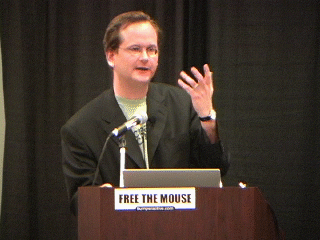 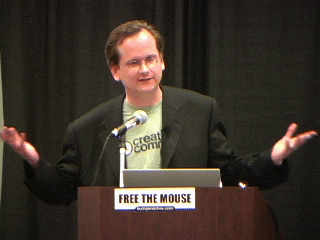 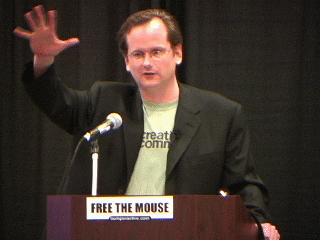 |
The Presentation and part of the Q and A in "Small" web video files in 3 Parts, plus a separate file of the Q and A: Lessig At SXSW 2003 - Part 1 of 3 (Small - 11 MB) Lessig At SXSW 2003 - Part 2 of 3 (Small - 14 MB) Lessig At SXSW 2003 - Part 3 of 3 (Small - 4 MB) Lessig At SXSW 2003 - Complete Q and A (Small - 22 MB)
Audio - Lessig At SXSW 2003 Part 1 of 3 (MP3 - 28 MB) Audio - Lessig At SXSW 2003 Part 2 of 3 (MP3 - 28 MB) Audio - Lessig At SXSW 2003 Part 3 of 3 (MP3 - 18 MB) Audio - Lessig At SXSW 2003 Q and A (MP3 - 15 MB) |
Hi-resolution Files of Presentation (Parts 1-6) and Q and A Answers Afterwards:
Lessig At SXSW 2003 Part 1 of 6 (Hi-Res - 150 MB)
(Includes Part 1 of Lessig's presentation.)
Lessig At SXSW 2003 Part 2 of 6 (Hi-Res - 153 MB)
(Includes Part 2 of Lessig's presentation.)
Lessig At SXSW 2003 Part 3 of 6 (Hi-Res - 167 MB)
(Includes Part 3 of Lessig's presentation.)
Lessig At SXSW 2003 Part 4 of 6 (Hi-Res - 160 MB)
(Includes Part 4 of Lessig's presentation.)
Lessig At SXSW 2003 Part 5 of 6 (Hi-Res - 144 MB)
(Includes Part 5 of Lessig's presentation.)
Lessig At SXSW 2003 Part 6 of 6 (Hi-Res - 60 MB)
(Includes Part 6 of Lessig's presentation.)
Lessig At SXSW 2003 - Q and A (Hi-Res - 268 MB)
(Includes Complete Answers during Q and A with Lessig after his presentation.)

This work is dedicated to the
Public Domain. (Take it and run, baby!)
I'll be at 340 Townsend at 5pm sharp tonight for a rally against Clear Channel.
Look for one in your town. (Here's one going on in Washington D.C.
Remember to bring your video cameras! I can always store your footage in my library at the Internet Archive if you don't have the space or bandwidth to do so.
See you there!
SAN FRANCISCO, CA
WHAT: No More Clear Channels!
Stop the FCC Media Giveaway
WHEN: Thursday, May 29th 2003 5 PM -
(the Thursday before the FCC votes to
dramatically deregulate the media)
WHERE: 340 Townsend Street, San Francisco
The FCC is poised to approve the most dramatic
changes to media ownership regulations in
decades. Leading the charge is FCC Chairman
Michael Powell, Colin Powell's son, who
essentially declared war on diversity in
media at the same time that his father was
spearheading the war against Iraq.
The Thursday before the June 2 FCC vote,
media activists and concerned citizens will
protest at Clear Channel radio stations
throughout the United States with the
message: No More Clear Channels!
Stop the FCC Media Giveaway!
Clear Channel Communications is the
poster child of everything that's wrong with
media deregulation. After the media
deregulation of 1996, Clear Channel gobbled
up hundreds of radio stations throughout
the country and now owns more than 1200
stations nationwide, dominating the audience
share in 100 of 112 major markets. Not only
is the company the world's largest radio
broadcaster, it's also the world largest
concert promoter and billboard advertising
firm. Clear Channel promotes a cookie-cutter
style radio that has urban stations
throughout the country seemingly playing the
same seven songs. It shuts out independent
artists and eliminates local programming.
The company also uses its stations to promote
its right-wing political agenda, such as the
pro-war rallies that Clear Channel
has sponsored in numerous cities since
the start of the war against Iraq.
In San Francisco, Clear Channel station
KMEL fired popular public affairs director
Davey D after he invited anti-war
Congresswoman Barbara Lee to speak on
a KMEL public affairs show.
Let's send a message to the FCC and Congress before
the FCC vote on media deregulation:
PROTEST CLEAR CHANNEL RADIO AND THE MEDIA MONOPOLY!
Location:
Clear Channel/KMEL Office, 340 Townsend Street
San Francisco California
Sponsored By:
Sponsored by Media Alliance, Youth Media Council,
Global Exchange, and others. For more information,
415-255-7296 x263, andrea@globalexchange.org.
Update 6/17/03: There has been an important development in this story.
There are two parts: Part 1 from the May 13, 2003 broadcast and Part 2 from the May 14, 2003 broadcast.
The other articles and blog links below are just FYI in case you wish to learn more about what happened. I'm still trying to understand it completely myself, but it sure is fun to watch!
May 13, 2003 Broadcast:
Daily Show On The Texas Democrat Walk Out - Part 1 of 2 (Small - 7 MB)
Daily Show On The Texas Democrat Walk Out - Part 1 of 2 (Hi-Res - 93 MB)
Audio - Daily Show On The Texas Democrat Walk Out - Part 1 of 2 (MP3 - 4 MB)
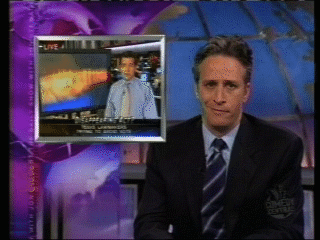
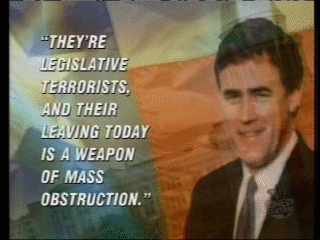
May 14, 2003 Broadcast:
Daily Show On The Texas Democrat Walk Out - Part 2 of 2 (Small - 5 MB)
Daily Show On The Texas Democrat Walk Out - Part 2 of 2 (Hi-Res - 70 MB)
Audio - Daily Show On The Texas Democrat Walk Out - Part 2 of 2 (MP3 - 3 MB)

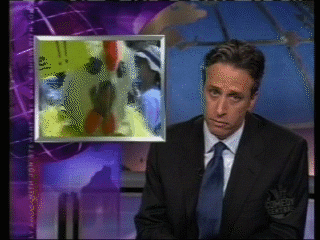
The Daily Show -- the best news on television.
Bid to Find Tex. Lawmakers Decried
Federal Workers Were Led to Believe They Were Looking for Downed or Lost Plane
By Christopher Lee for the Washington Post.
Over 50 Texas Democrats Remain on the Lam
By April Castro for the Associated Press.
Here is the full text of the article in case the link goes bad:
(the other article is included below this one)
http://www.washingtonpost.com/wp-dyn/articles/A61464-2003May15.html
Bid to Find Tex. Lawmakers Decried
Federal Workers Were Led to Believe They Were Looking for Downed or Lost Plane
By Christopher Lee
Washington Post Staff Writer
Friday, May 16, 2003; Page A27
A Texas political battle turned into a matter of national security for a few hours this week when state officials enlisted the U.S. Department of Homeland Security to help track down more than 50 Democratic state lawmakers who had vanished from Austin.
The Democrats fled the state over the weekend, depriving House Speaker Tom Craddick, a Republican, of the quorum he needed to pass several controversial bills, including one that would redraw Texas's congressional districts in favor of the GOP. On Monday, Craddick and other Republicans dispatched state troopers to round up the legislative fugitives and bring them back to the Texas Capitol.
State police officials, in turn, called in federal help as they pursued a rumor that Rep. James E. "Pete" Laney, a former Texas House speaker, had ferried fellow Democrats out of state aboard his Piper turboprop airplane. A state investigator called the Air and Marine Interdiction Coordination Center in Riverside, Calif., part of the Homeland Security Department, to ask officials there to use their nationwide radar network to help locate the plane.
The call from the unnamed investigator came as an "urgent plea," describing a plane with state officials aboard that was overdue, according to a statement issued yesterday by the Homeland Security Department's Bureau of Immigration and Customs Enforcement.
"We got a problem, and I hope you can help me out," the statement quoted the officer as saying. "We had a plane that was supposed to be going from Ardmore, Okla., to Georgetown, Tex. It had state representatives on it, and we cannot find this plane."
Believing they had an emergency on their hands, agency officials called the Federal Aviation Administration in Fort Worth, and airport officials in two other Texas cities, but were unable to find the plane.
"When law enforcement calls us asking for assistance in locating an aircraft that may be missing or lost or downed, it's certainly an appropriate response to try to locate that aircraft," said Dean Boyd, a spokesman for the bureau. "We take these statements at face value."
In fact, there was no plane. Most of the Democrats had taken buses to Ardmore, where they holed up in a hotel. They were expected to stay there until at least midnight last night -- the deadline for new bills to be brought to the House floor.
The only thing in jeopardy was the GOP legislative agenda.
Democrats in Washington seized on the episode yesterday after the Fort Worth Star-Telegram and the Dallas Morning News reported on the incident this week. Several vented their outrage on the House floor yesterday. They accused Craddick and House Majority Leader Tom DeLay (R-Tex.), the chief proponent of the redistricting plan, of misusing their official powers for political ends. They said both Republicans had turned to the Justice Department as well as to Homeland Security for help.
"Not since Richard Nixon and Watergate 30 years ago has anyone tried to use law enforcement agencies of the federal government for domestic political purposes," Rep. Martin Frost (D-Tex.), a longtime foe of DeLay in redistricting battles, said in an interview. "This is an abuse of criminal- and terrorist-fighting resources of the U.S. government for a domestic political matter. . . . There should be a complete investigation."
Rep. Jim Turner (Tex.), ranking Democrat on the House Select Committee on Homeland Security, said it was "deeply disturbing" that federal resources were diverted to try to track down Laney, who, in a show of bipartisanship, had introduced George W. Bush before the president-elect gave a speech after the Supreme Court settled the outcome of the 2000 election.
"We created the Department of Homeland Security to track down terrorists, not law-abiding citizens," Turner said.
Rep. John Conyers Jr. of Michigan, the ranking Democrat on the House Judiciary Committee, joined eight other House Democrats yesterday in asking the acting inspector general at Homeland Security to investigate what happened.
"If true, this report represents a shameful diversion of taxpayer resources for partisan purposes," the lawmakers wrote to Clark Kent Irvin.
DeLay spokesman Jonathan Grella said DeLay did not seek federal help in forcing the Democrats back to Austin. DeLay did pass along to the Justice Department Craddick's inquiry on whether federal law enforcement could assist in the manhunt, Grella said.
"We've had no contact with Homeland or the FBI," said Grella, who asserted that Democrats were trying to detract attention from their "shirking" of their legislative duties in Austin.
"This is a smoke screen," Grella said. "[W]e certainly are disappointed that they've resorted to flat-out lying to hold on to power."
A spokesman for Craddick, who became speaker this year after Republicans won control of the House for the first time since Reconstruction, said Craddick did not tell the state police to seek federal help.
"He called them [state police] in and let them do their job," said Bob Richter, the spokesman. "There was an effort made to find out if they could get some federal help in that. It was either turned down, or they found out they couldn't do it. By the end of the day Monday, it was a dead issue [because the lawmakers were found]. . . . I think Craddick is getting credit for a lot of things other people did. He may have said, 'Let's do what we can to find them.' "
Tom Vinger, a spokesman for the state Department of Public Safety, said it was routine to seek federal assistance. "We feel that we conducted a thorough and professional investigation," he said.
Richter said Craddick just wants the Democrats to come back and has acknowledged that the House will not take up the redistricting bill this session, which ends June 2. "He's repeatedly said there's not going to be retaliation," Richter said. "He wants to get back to business and salvage what we can."
Late yesterday, the Associated Press reported that Democrats declared victory and posed for a photograph at the Holiday Inn in Ardmore. "Now that we have been able to kill redistricting, we are able to go back and finish the business of this state," state Rep. Craig Eiland said.
Here is the full text of the article (below) in case the link goes bad:
http://www.guardian.co.uk/uslatest/story/0,1282,-2671636,00.html
Over 50 Texas Democrats Remain on the Lam
Tuesday May 13, 2003 6:59 PM
By APRIL CASTRO
Associated Press Writer
AUSTIN, Texas (AP) - Three Democrats returned to the Capitol on Tuesday, but more than 50 remained on the lam in Oklahoma, frustrating Republican efforts to push through a plan to redraw the state's congressional districts.
The rebellious Democrats were holed up at a hotel in Ardmore, Okla. They sneaked out of Austin on Sunday after spending several days discussing ways to derail a GOP plan to redraw the districts that seeks to increase the number of Republican seats.
With 58 Democrats gone on Monday, the 150-member House was unable to muster the two-thirds quorum needed to conduct business. House Speaker Tom Craddick called the House to order Tuesday morning but even with the return of three Democrats, there still were enough missing to block any House business.
The three returning Democrats were welcomed back into the House chamber with hugs and supportive words from their Republican colleagues. One Democrat, Rep. Helen Giddings, fought back tears as she stated her desire to stop the redistricting plan.
The defiant Democrats in Oklahoma said they would stay away until Republicans agreed to drop the redistricting plan.
"It's totally up to Craddick, and he has been so advised," one of the Democrats told The Associated Press on the condition of anonymity. "If he'll get redistricting off the calendar, we'll be right there bright and early."
Craddick said he was not interested in negotiating.
Republicans constructed signs and gimmicks ridiculing their colleagues. They plastered the Democrats' faces on milk cartons, and state Republican chair Susan Weddington, borrowing from the "most wanted Iraqi" cards, announced she had playing cards featuring the missing legislators.
House rules allow state troopers to arrest lawmakers and bring them back to the Capitol. On Monday, Craddick had ordered troopers to find the missing lawmakers, arrest them and bring them back to Austin. Several agents arrived at the Democrats' hotel in Ardmore on Monday night but they did not have jurisdiction outside of Texas and did not have a warrant issued by Oklahoma authorities.
Instead, the troopers asked the legislators to board their aircraft and return home, but the lawmakers refused.
The capped months of tension between Democrats and the newly-in-control Republicans.
"They're legislative terrorists and their leaving today is a weapon of mass obstruction, blocking hundreds of pieces of legislation," Republican Rep. Dan Branch said Monday.
The Democrats said they were taking a stand for fair treatment of the minority party. They said U.S. House Majority Leader Tom DeLay, R-Texas, had pushed the Texas House to take up the issue of congressional redistricting instead of more pressing matters, such as the state budget.
"There are some issues that are important to us, important to all Texans," Rep. Pete Gallego said.
The state already has a court-drawn redistricting map, but Republicans say it doesn't match state voting trends and want to redo the plan. Their proposal could add five to seven GOP House seats to the 15 already in Republican hands. The state has 32 members in the U.S. House.
Redistricting had been scheduled on the House calendar for Monday. The deadline for preliminarily votes on House bills is Thursday or they risk dying for the session, which ends June 2.
The Texas House cannot convene without at least 100 of the 150 members present. The body has 88 Republicans and 62 Democrats. Four Democrats had stayed behind and the whereabouts of four others were not known.
The missing Democratic lawmakers spent Monday in a hotel conference room, where large sheets of paper taped to the walls were used as makeshift chalkboards and long tables were filled with laptop computers, stacks of papers and notebooks.
They said they discussed school financing, homeowners insurance and other issues.
Republican Gov. Rick Perry lambasted the Democrats for deserting the Legislature, saying "we might as well shut this building down and let it become a museum because the work of the people is through."
The Republicans and the few Democrats who were left milled around. Some left the chamber and were elsewhere in the Capitol. They weren't be required to stay on the House floor Tuesday as they had all day Monday.
Craddick said Perry assured him he would call a special session after the regular session if it's needed.
The walkout came 24 years to the month since a group of 12 Texas state senators defied then-Lt. Gov. Bill Hobby by refusing to show up at the Capitol.
Some of the "Killer Bees," as the 12 Democrats came to be known, hid out in a west Austin garage apartment while troopers, Texas Rangers and legislative sergeants-at-arms unsuccessfully combed the state for them.
^---
On the Net:
http://www.capitol.state.tx.us
Let us not forget the extent of the fabrications about the Jessica Lynch rescue story. We are not talking about the fine points surrounding whether or not the hospital was occupied enough (or not) by enemy Iraq troops to warrant the Hollywood-type SWAT team recovery. Or how a rescue wouldn't have been necessary if troops hadn't opened fire on an ambulence trying to deliver Lynch.
I'm more upset about reports from "U.S. Officials", such as this MSNBC story which embellishes about how Lynch shot several enemy soldiers before running out of ammunition after an ambush. How she "did not want to be taken alive."
In fact, there was no ambush. No battle. Only a car accident.
No bullets. No stab wounds.
This from April 3, 2003:
Rescued POW put up fierce fight
Details emerge of W.Va. soldier’s capture and rescue
By Susan Schmidt and Vernon Loeb for the Washington Post
Jessica Lynch, rescued Tuesday from an Iraqi hospital, fought fiercely and shot several enemy soldiers after Iraqi forces ambushed the Army’s 507th Ordnance Maintenance Company, firing her weapon until she ran out of ammunition, U.S. officials said yesterday.LYNCH, A 19-YEAR-OLD supply clerk, continued firing at the Iraqis even after she sustained multiple gunshot wounds and watched several other soldiers in her unit die around her in fighting March 23, one official said. The ambush took place after a 507th convoy, supporting the advancing 3rd Infantry Division, took a wrong turn near the southern city of Nasiriyah.
‘FIGHTING TO THE DEATH’
“She was fighting to the death,” the official said. “She did not want to be taken alive.”
Here is the full text of the article in case the link goes bad:
http://stacks.msnbc.com/news/894669.asp
Image: Lynch
U.S. Army Pfc. Jessica Lynch is carried off a C-17 military plane at the U.S. air base in Ramstein, Germany, early Thursday.
Rescued POW
put up fierce fight
Details emerge of W.Va. soldier’s capture and rescue
By Susan Schmidt and Vernon Loeb
THE WASHINGTON POST
April 3 — Pfc. Jessica Lynch, rescued Tuesday from an Iraqi hospital, fought fiercely and shot several enemy soldiers after Iraqi forces ambushed the Army’s 507th Ordnance Maintenance Company, firing her weapon until she ran out of ammunition, U.S. officials said yesterday.
LYNCH, A 19-YEAR-OLD supply clerk, continued firing at the Iraqis even after she sustained multiple gunshot wounds and watched several other soldiers in her unit die around her in fighting March 23, one official said. The ambush took place after a 507th convoy, supporting the advancing 3rd Infantry Division, took a wrong turn near the southern city of Nasiriyah.
‘FIGHTING TO THE DEATH’
“She was fighting to the death,” the official said. “She did not want to be taken alive.”
• Family overwhelmed with pride, relief
• Iraqis plan for climactic defense of the capital
• Maps of Iraq
• War in Iraq special report
Lynch was also stabbed when Iraqi forces closed in on her position, the official said, noting that initial intelligence reports indicated that she had been stabbed to death. No official gave any indication yesterday, however, that Lynch’s wounds had been life-threatening.
Several officials cautioned that the precise sequence of events is still being determined, and that further information will emerge as Lynch is debriefed. Reports thus far are based on battlefield intelligence, they say, which comes from monitored communications and from Iraqi sources in Nasiriyah whose reliability has yet to be assessed. Pentagon officials said they had heard “rumors” of Lynch’s heroics but had no confirmation.
There was no immediate indication whether Lynch’s fellow soldiers killed in the ambush were among 11 bodies found by Special Operations forces who rescued Lynch at Saddam Hussein Hospital in Nasiriyah. U.S. officials said that at least some of the bodies are believed to be those of U.S. servicemen. Two of the bodies were found in the hospital’s morgue, and nine were found in shallow graves on the grounds outside.
Seven soldiers from the 507th are still listed as missing in action following the ambush. Five others, four men and a woman, were taken captive after the attack. Video footage of the five has been shown on Iraqi television, along with grisly pictures of at least four soldiers killed in the battle.
AdvertisementClick Here!
Add local news and weather to the MSNBC home page.
Lynch, of Palestine, W.Va., arrived yesterday at a U.S. military hospital in Germany. She was in “stable” condition, with broken arms and a broken leg in addition to the gunshot and stab wounds, sources said. Other sources said both legs were broken, and one arm. Victoria Clarke, a Pentagon spokeswoman, gave no specifics of Lynch’s condition, telling reporters only that she is “in good spirits and being treated for injuries.”
But one military officer briefed on her condition said that while Lynch was conscious and able to communicate with the U.S. commandos who rescued her, “she was pretty messed up.” Last night Lynch spoke by telephone with her parents, who said she was in good spirits, but hungry and in pain.
‘TALK ABOUT SPUNK!’
“Talk about spunk!” said Sen. Pat Roberts (R-Kan.), whom military officials had briefed on the rescue. “She just persevered. It takes that and a tremendous faith that your country is going to come and get you.”
One Army official said that it could be some time before Lynch is reunited with her family, since experience with those taken prisoner since the Vietnam War indicates that soldiers held in captivity need time to “decompress” and reflect on their ordeal with the help of medical professionals.
“It’s real important to have decompression time before they get back with their families to assure them that they served their country honorably,” the official said. “She’ll meet with Survival, Escape, Resistance and Evasion psychologists. These are medical experts in dealing with this type of things.”
At Central Command headquarters in Qatar, Brig. Gen. Vincent Brooks showed a brief night-vision video clip of commandos rushing Lynch, on a stretcher, to a Black Hawk helicopter. Later, television networks showed footage of her arriving in Germany.
One intriguing account of Lynch’s captivity came from an unidentified Iraqi pharmacist at Saddam Hussein Hospital who told Sky News, a British network, that he had cared for her and heard her crying about wanting to be reunited with her family.
“She said every time, about wanting to go home,” said the pharmacist, who was filmed at the hospital wearing a white medical coat over a black T-shirt. “She knew that the American Army and the British were on the other side of the [Euphrates] river in Nasiriyah city. ... She said, ‘Maybe this minute the American Army [will] come and get me.’ ” The only injuries the pharmacist said he was aware of were to Lynch’s leg, but there was no way to evaluate his statement.
CLASSIC SPECIAL OPS
Lynch’s rescue at midnight local time Tuesday was a classic Special Operations raid, with U.S. commandos in Black Hawk helicopters engaging Iraqi forces on their way in and out of the medical compound, defense officials said.
• Complete MSNBC coverage
• Judging the occupation
• Kurd diaspora eyes return
• Hizballah's deep roots
• What's the Iraq bodycount?
• Who will win the oil bonanza?
• Saving the cancer children
• What role for the U.N.?
• Occupation without precedent
• Dispatches from the field
• Slideshow of postwar Iraq
• Encarta: Detailed Iraq map
• WashPost: Special coverage
LATEST FROM NEWSWEEK
• Special war section
Acting on information from CIA operatives, they said, a Special Operations force of Navy SEALs, Army Rangers and Air Force combat controllers touched down in blacked-out conditions. An AC-130 gunship, able to fire 1,800 rounds a minute from its 25mm cannon, circled overhead, as did a reconnaissance aircraft providing video imagery of the operation as it unfolded.
“There was shooting going in, there was some shooting going out,” said one military officer briefed on the operation. “It was not intensive. There was no shooting in the building, but it was hairy, because no one knew what to expect. When they got inside, I don’t think there was any resistance. It was fairly abandoned.”
Meanwhile, U.S. Marines advanced in Nasiriyah to divert whatever Iraqi forces might still have been in the area.
The officer said that Special Operations forces found what looked like a “prototype” Iraqi torture chamber in the hospital’s basement, with batteries and metal prods.
Briefing reporters at Central Command headquarters, Brooks said the hospital apparently was being used as a military command post. Commandos whisked Lynch to the Black Hawk helicopter that had landed inside the hospital compound, he said, while others remained behind to clear the hospital.
The announcement of the raid was delayed for more than an hour yesterday because some U.S. troops had remained on the ground longer than anticipated, Brooks said. “We wanted to preserve the safety of the forces,” he said.
Correspondent Alan Sipress in Qatar and staff writer Dana Priest contributed to this report.
No sooner had I created a category for the Starbucks photos (actually, even before I'd created a category), when what did I see?
http://www.starbucksphotos.com/ smiling back me...
The Christian Science Monitor sent its own reporter with a radiation detector to verify whether or not the depleted uranium bullets used by U.S. forces in Iraq were leaving radiation behind.
The answer is a frighteningly loud and clear: yes! The whole place is contaminated and no one is warning or protecting the inhabitants.
Remains of toxic bullets litter Iraq
The Monitor finds high levels of radiation left by US armor-piercing shells.
By Scott Peterson for the Christian Science Monitor.
At a roadside produce stand on the outskirts of Baghdad, business is brisk for Latifa Khalaf Hamid. Iraqi drivers pull up and snap up fresh bunches of parsley, mint leaves, dill, and onion stalks.But Ms. Hamid's stand is just four paces away from a burnt-out Iraqi tank, destroyed by - and contaminated with - controversial American depleted-uranium (DU) bullets. Local children play "throughout the day" on the tank, Hamid says, and on another one across the road.
No one has warned the vendor in the faded, threadbare black gown to keep the toxic and radioactive dust off her produce. The children haven't been told not to play with the radioactive debris. They gather around as a Geiger counter carried by a visiting reporter starts singing when it nears a DU bullet fragment no bigger than a pencil eraser. It registers nearly 1,000 times normal background radiation levels on the digital readout.
The Monitor visited four sites in the city - including two randomly chosen destroyed Iraqi armored vehicles, a clutch of burned American ammunition trucks, and the downtown planning ministry - and found significant levels of radioactive contamination from the US battle for Baghdad.
In the first partial Pentagon disclosure of the amount of DU used in Iraq, a US Central Command spokesman told the Monitor that A-10 Warthog aircraft - the same planes that shot at the Iraqi planning ministry - fired 300,000 bullets. The normal combat mix for these 30-mm rounds is five DU bullets to 1 - a mix that would have left about 75 tons of DU in Iraq.
The Monitor saw only one site where US troops had put up handwritten warnings in Arabic for Iraqis to stay away. There, a 3-foot-long DU dart from a 120 mm tank shell, was found producing radiation at more than 1,300 times background levels. It made the instrument's staccato bursts turn into a steady whine...
During the latest Iraq conflict Abrams tanks, Bradley fighting vehicles and A-10 Warthog aircraft, among other military platforms, all fired the DU bullets from desert war zones to the heart of Baghdad. No other armor-piercing round is as effective against enemy tanks. While the Pentagon says there's no risk to Baghdad residents, US soldiers are taking their own precautions in Iraq, and in some cases have handed out warning leaflets and put up signs.
"After we shoot something with DU, we're not supposed to go around it, due to the fact that it could cause cancer," says a sergeant in Baghdad from New York, assigned to a Bradley, who asked not to be further identified.
"We don't know the effects of what it could do," says the sergeant. "If one of our vehicles burnt with a DU round inside, or an ammo truck, we wouldn't go near it, even if it had important documents inside. We play it safe."
Six American vehicles struck with DU "friendly fire" in 1991 were deemed to be too contaminated to take home, and were buried in Saudi Arabia. Of 16 more brought back to a purpose-built facility in South Carolina, six had to be buried in a low-level radioactive waste dump.
Television footage of the war last month showed Iraqi armored vehicles burning as US columns drove by, a common sign of a strike by DU, which burns through armor on impact, and often ignites the ammunition carried by the targeted vehicle.
"We were buttoned up when we drove by that - all our hatches were closed," the US sergeant says. "If we saw anything on fire, we wouldn't stop anywhere near it. We would just keep on driving."
Here is the full text of the article in case the link goes bad:
http://www.csmonitor.com/2003/0515/p01s02-woiq.html
Specials > Iraq in Transition
from the May 15, 2003 edition
(Photograph)
CONTAMINATED SITES: Monitor correspondent Scott Peterson uses a radiation detector to test contamination levels of an Iraqi tank destroyed by US depleted uranium bullets.
SCOTT PETERSON/
GETTY IMAGES
Remains of toxic bullets
litter Iraq
The Monitor finds high levels of radiation left by US armor-piercing shells.
By Scott Peterson | Staff writer of The Christian Science Monitor
Page 1 | 2
BAGHDAD – At a roadside produce stand on the outskirts of Baghdad, business is brisk for Latifa Khalaf Hamid. Iraqi drivers pull up and snap up fresh bunches of parsley, mint leaves, dill, and onion stalks.
But Ms. Hamid's stand is just four paces away from a burnt-out Iraqi tank, destroyed by - and contaminated with - controversial American depleted-uranium (DU) bullets. Local children play "throughout the day" on the tank, Hamid says, and on another one across the road.
No one has warned the vendor in the faded, threadbare black gown to keep the toxic and radioactive dust off her produce. The children haven't been told not to play with the radioactive debris. They gather around as a Geiger counter carried by a visiting reporter starts singing when it nears a DU bullet fragment no bigger than a pencil eraser. It registers nearly 1,000 times normal background radiation levels on the digital readout.
The Monitor visited four sites in the city - including two randomly chosen destroyed Iraqi armored vehicles, a clutch of burned American ammunition trucks, and the downtown planning ministry - and found significant levels of radioactive contamination from the US battle for Baghdad.
In the first partial Pentagon disclosure of the amount of DU used in Iraq, a US Central Command spokesman told the Monitor that A-10 Warthog aircraft - the same planes that shot at the Iraqi planning ministry - fired 300,000 bullets. The normal combat mix for these 30-mm rounds is five DU bullets to 1 - a mix that would have left about 75 tons of DU in Iraq.
The Monitor saw only one site where US troops had put up handwritten warnings in Arabic for Iraqis to stay away. There, a 3-foot-long DU dart from a 120 mm tank shell, was found producing radiation at more than 1,300 times background levels. It made the instrument's staccato bursts turn into a steady whine.
"If you have pieces or even whole [DU] penetrators around, this is not an acute health hazard, but it is for sure above radiation protection dose levels," says Werner Burkart, the German deputy director general for Nuclear Sciences and Applications at the UN's International Atomic Energy Agency (IAEA) in Vienna. "The important thing in any battlefield - especially in populated urban areas - is somebody has to clean up these sites."
Minimizing the risk
Fresh-from-the-factory DU tank shells are normally handled with gloves, to minimize the health risk, and shielded with a thin coating. The alpha particle radiation emitted by DU travels less than an inch and can be stopped by cloth or even tissue paper. But when the DUmaterial burns (usually on impact; or as a dust, it can spontaneously ignite) protective shields disappear, and dangerous radioactive oxides are created that can be inhaled or ingested.
"[The risk] depends so very much on how you handle it," says Jan Olof Snihs, of Sweden's Radiation Protection Authority in Stockholm. In most cases dangers are low, he says, unless children eat toxic and radioactive soil, or get DU oxides on their hands.
Radioactive particles are a "special risk associated with a war," Mr. Snihs says. "The authorities should be aware of this, and try to decontaminate places like this, just to avoid unnecessary risk."
Pentagon officials say that DU is relatively harmless and a necessary part of modern warfare. They say that pre-Gulf War studies that indicated a risk of cancer and of causing harm to local populations through permanent contamination have been superseded by newer reports.
"There is not really any danger, at least that we know about, for the people of Iraq," said Lt. Col. Michael Sigmon, deputy surgeon for the US Army's V Corps, told journalists in Baghdad last week. He asserted that children playing with expended tank shells would have to eat and then practically suffocate on DU residue to cause harm.
But there is a growing chorus of concern among United Nations and relief officials, along with some Western scientific experts, who are calling for sites contaminated with DU be marked off and made safe.
"The soil around the impact sites of [DU] penetrators may be heavily contaminated, and could be harmful if swallowed by children," says Brian Spratt, chair of the working group on DU at The Royal Society, Britain's premier scientific institution.
Heavy metal toys?
Fragments and penetrators should be removed, since "children find them fascinating objects, and can pocket them," says Professor Spratt. "The science says there is some danger - not perhaps a huge danger - of these objects. ... We certainly do not say that these things are safe; we say that cleanup is important."
The British Ministry of Defense says it will offer screening to soldiers suspected of DU exposure, and will publish details about locations and quantities of DU that British troops used in Iraq - a tiny fraction of that fired by US forces.
The Pentagon has traditionally been tight-lipped about DU: Official figures on the amount used were not released for years after the 1991 Gulf War and Bosnia conflicts, and nearly a year after the 1999 Kosovo campaign. No US official contacted could provide DU use estimates from the latest war in Iraq.
"The first thing we should ask [the US military] is to remove that immediately," says Carel de Rooy, head of the UN Children's Fund in Baghdad, adding that senior UN officials need urgent advice on avoiding exposure.
The UN Environment Program last month called for field tests. DU "is still an issue of great concern for the general public," said UNEP chief Klaus Töpfer. "An early study in Iraq could either lay these fears to rest or confirm that there are indeed potential risks."
US troops avoid wreckage
During the latest Iraq conflict Abrams tanks, Bradley fighting vehicles and A-10 Warthog aircraft, among other military platforms, all fired the DU bullets from desert war zones to the heart of Baghdad. No other armor-piercing round is as effective against enemy tanks. While the Pentagon says there's no risk to Baghdad residents, US soldiers are taking their own precautions in Iraq, and in some cases have handed out warning leaflets and put up signs.
"After we shoot something with DU, we're not supposed to go around it, due to the fact that it could cause cancer," says a sergeant in Baghdad from New York, assigned to a Bradley, who asked not to be further identified.
"We don't know the effects of what it could do," says the sergeant. "If one of our vehicles burnt with a DU round inside, or an ammo truck, we wouldn't go near it, even if it had important documents inside. We play it safe."
Six American vehicles struck with DU "friendly fire" in 1991 were deemed to be too contaminated to take home, and were buried in Saudi Arabia. Of 16 more brought back to a purpose-built facility in South Carolina, six had to be buried in a low-level radioactive waste dump.
Television footage of the war last month showed Iraqi armored vehicles burning as US columns drove by, a common sign of a strike by DU, which burns through armor on impact, and often ignites the ammunition carried by the targeted vehicle.
"We were buttoned up when we drove by that - all our hatches were closed," the US sergeant says. "If we saw anything on fire, we wouldn't stop anywhere near it. We would just keep on driving."
That's an option that produce seller Hamid doesn't have.
She says the US broke its promise not to bomb civilians. She has found US cluster bomblets in her garden; the DU is just another dangerous burden, in a war about which she remains skeptical.
"We were told it was going to be paradise [when Saddam Hussein was toppled], and now they are killing our children," she says voicing a common Iraqi perception about the risk of DU. "The Americans did not bother to warn us that this is a contaminated area."
There is a warning now at the Doura intersection on the southern outskirts of Baghdad. In the days before the capital fell, four US supply trucks clustered near an array of highway off-ramps caught fire, cooking off a number of DU tank rounds.
American troops wearing facemasks for protection arrived a few days later and bulldozed the topsoil around the site to limit the contamination.
The troops taped handwritten warning signs in Arabic to the burned vehicles, which read: "Danger - Get away from this area." These were the only warnings seen by this reporter among dozens of destroyed Iraqi armored vehicles littering the city.
"All of them were wearing masks," says Abbas Mohsin, a teenage cousin of a drink seller 50 yards away, said referring to the US military cleanup crew. "They told the people there were toxic materials ... and advised my cousin not to sell Pepsi and soft drinks in this area. They said they were concerned for our safety."
Despite the troops' bulldozing of contaminated earth away from the burnt vehicles, black piles of pure DU ash and particles are still present at the site. The toxic residue, if inhaled or ingested, is considered by scientists to be the most dangerous form of DU.
One pile of jet-black dust yielded a digital readout of 9,839 radioactive emissions in one minute, more than 300 times average background levels registered by the Geiger counter. Another pile of dust reached 11,585 emissions in a minute.
Western journalists who spent a night nearby on April 10, the day after Baghdad fell, were warned by US soldiers not to cross the road to this site, because bodies and unexploded ordnance remained, along with DU contamination. It was here that the Monitor found the "hot" DU tank round.
This burned dart pushed the radiation meter to the far edge of the "red zone" limit.
A similar DU tank round recovered in Saudi Arabia in 1991, that was found by a US Army radiological team to be emitting 260 to 270 millirads of radiation per hour. Their safety memo noted that the "current [US Nuclear Regulatory Commission] limit for non-radiation workers is 100 millirads per year."
The normal public dose limit in the US, and recognized around much of the world, is 100 millirems per year. Nuclear workers have guidelines 20 to 30 times as high as that.
The depleted-uranium bullets are made of low-level radioactive nuclear-waste material, left over from the making of nuclear fuel and weapons. It is 1.7 times as dense as lead, and burns its way easily through armor. But it is controversial because it leaves a trail of contamination that has half-life of 4.5 billion years - the age of our solar system.
Bush Officials Change Tune on Iraqi Weapons
By Alan Elsner for Reuters.
The change in rhetoric, apparently designed in part to dampen public expectations, has unfolded gradually in the past month as special U.S. military teams have found little to justify the administration's claim that Iraq was concealing vast stocks of chemical and biological agents and was actively working on a covert nuclear weapons program."The administration seems to be hoping that inconvenient facts will disappear from the public discourse. It's happening to a large degree," said Phyllis Bennis of the Institute for Policy Studies, a liberal think-tank which opposed the war...
President Bush's national security adviser, Condoleezza Rice, told Reuters on Monday that Washington was sending a new team to Iraq to scour for evidence.
The new team will be "more expert" at following the paper trail and other intelligence. She said Iraq appeared to have had a virtually "inspections proof" system of concealing chemical and biological weapons by developing chemicals and agents that could be used for more than one purpose, but that could be put together as weapons at the last minute.
She said U.S. officials never expected that "we were going to open garages and find" weapons of mass destruction.
Here is the full text of the article in case the link goes bad:
http://story.news.yahoo.com/news?tmpl=story&cid=584&ncid=584&e=5&u=/nm/20030514/pl_nm/iraq_usa_weapons_dc
Bush Officials Change Tune on Iraqi Weapons
By Alan Elsner
Reuters
Wednesday 14 May 2003
WASHINGTON - The Bush administration has changed its tune on Iraqi weapons of mass destruction, the reason it went to war there. Instead of looking for vast stocks of banned materials, it is now pinning its hopes on finding documentary evidence.
The change in rhetoric, apparently designed in part to dampen public expectations, has unfolded gradually in the past month as special U.S. military teams have found little to justify the administration's claim that Iraq was concealing vast stocks of chemical and biological agents and was actively working on a covert nuclear weapons program.
"The administration seems to be hoping that inconvenient facts will disappear from the public discourse. It's happening to a large degree," said Phyllis Bennis of the Institute for Policy Studies, a liberal think-tank which opposed the war.
Few politicians have raised the issue, not wishing to question a popular military victory. However, California Rep. Jane Harman, ranking Democrat on the House of Representatives Intelligence Committee, said last week she was concerned.
"Though I was convinced of the case made prior to the war, I am increasingly concerned about the lack of progress in uncovering the Iraqi weapons. We need a thorough accounting of what intelligence was available to Congress and war planners before and during the conflict," she said.
In a New York Times/CBS poll released on Tuesday, 49 percent said the administration overestimated the amount of banned weapons in Iraq, while 29 percent said its estimates were accurate and 12 percent said they were low.
Still, 56 percent said the war would still have been worthwhile even if weapons of mass destruction were never found, while 38 percent said it would not have been worth it.
President Bush's national security adviser, Condoleezza Rice, told Reuters on Monday that Washington was sending a new team to Iraq to scour for evidence.
The new team will be "more expert" at following the paper trail and other intelligence. She said Iraq appeared to have had a virtually "inspections proof" system of concealing chemical and biological weapons by developing chemicals and agents that could be used for more than one purpose, but that could be put together as weapons at the last minute.
She said U.S. officials never expected that "we were going to open garages and find" weapons of mass destruction.
CHANGE IN RHETORIC
That statement represents a dramatic change from rhetoric from Bush and other top officials before the war, backed up by a steady stream of documents, all of which are still accessible on the White House web site.
In his March 17 speech giving Iraqi President Saddam Hussein 48 hours to leave the country, Bush said: "Intelligence gathered by this and other governments leaves no doubt that the Iraq regime continues to possess and conceal some of the most lethal weapons ever devised."
Earlier, in a speech last Oct. 7, Bush said: "The Iraqi regime ... possesses and produces chemical and biological weapons. It is seeking nuclear weapons.
"We know that the regime has produced thousands of tons of chemical agents, including mustard gas, sarin nerve gas, VX nerve gas ... And surveillance photos reveal that the regime is rebuilding facilities that it had used to produce chemical and biological weapons."
In his State of the Union address last January, Bush accused Iraq of having enough material "to produce over 25,000 liters of anthrax -- enough doses to kill several million people ... more than 38,000 liters of botulinum toxin -- enough to subject millions of people to death by respiratory failure ... as much as 500 tons of sarin, mustard and VX nerve agent."
In his presentation to the U.N. Security Council on Feb. 6, Secretary of State Colin Powell said Washington "knew" that Baghdad had dispersed rocket launchers and warheads containing biological warfare agents to locations in western Iraq.
"We also have satellite photos that indicate that banned materials have recently been moved from a number of Iraqi weapons of mass destruction facilities," Powell said. "There can be no doubt that Saddam Hussein has biological weapons and the capability to rapidly produce more, many more."
In Congressional testimony in April, Powell said weapons "will be found." He said of his U.N speech, "everything we had there had backup and double sourcing and triple sourcing."
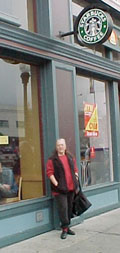 | My friend Bobby Lilly stopped off at Starbucks in Berkeley and took a snapshot of her visit. (More background on this here.) |

Today's stop: Oakland, California.
(These are two shots from the same Starbucks.)
Why am I starting to feel like a Starbucks spokesmodel?

(More background on this here.)
I went to sleep last night and woke up this morning thinking the same thoughts:
Never in a million years would I have ever predicted that I would be living in a world where I feel the need to take photographs inside of a Starbucks store in an attempt to somehow prove that I am still living in a free society.
Yes, the absurdity of it all does kick me in the teeth sometimes. Thanks for asking.
Lawrence Lessig was a bit upset yesterday at the prospect of Starbucks not allowing pictures to be taken inside of their stores.
I wonder what would happen if hundreds of people from around the country experimented this holiday weekend by taking pictures at their local Starbucks …
Sounded like a plan to me. I went to my nearest Starbucks right away to take some pictures -- moving pictures that is -- to help out with the experiment.
I had no problems whatsoever from the Starbucks staff while having my picture taken. They were their usually cheery selves behind the counter while everyone else in the store watched as I danced around holding up my venti iced soy latte.
Another customer took the shots of me, so they're a little shaky (even shakier than normal :-)
Tomorrow I'll have more time to visit a few more locations.
Perhaps you can do the same at a Starbucks in your town :-)
(When you do, be sure to post them to Larry's comment page.)
Taking Pictures Inside Starbucks - 24th St (Small - 2 MB)
Taking Pictures Inside Starbucks - 24th St (Hi-Res - 11 MB)
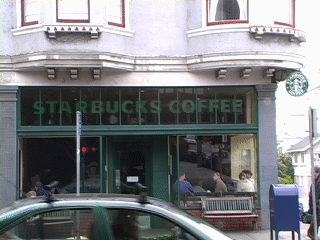
"We still live in a free society! Yay!"

Here is the full text in case the link goes bad:
http://cyberlaw.stanford.edu/lessig/blog/archives/2003_05.shtml#001223
dear Starbucks, say it ain’t true?
So I have this from an extremely reliable source, who vouches totally for the facts that follow.
Story one: Last month while visiting Charleston, three women went into a Starbucks. They were spending the weekend together and one of them had a disposable camera with her. To commemorate their time with one and other they decided to take round robin pictures while sitting around communing. The manager evidently careened out of control, screaming at them, “Didn’t they know it was illegal to take photographs in a Starbucks. She insisted that she had to have the disposable camera because this was an absolute violation of Starbuck’s copyright of their entire ‘environment’--that everything in the place is protected and cannot be used with Starbuck’s express permission.
Story two: At our local [North Carolina] Starbucks, a friend’s daughter, who often has her camera with her, was notified that she was not allowed to take pictures in any Starbucks. No explanation was given, but pressed I would think that the manager there would give a similar rationale.
I wonder what would happen if hundreds of people from around the country experimented this holiday weekend by taking pictures at their local Starbucks …
posted on [ May 23 03 at 2:10 PM ] to [ bad code ] [ 43 comments ]
Update On Cheney's Health (Small - 4 MB)
Update On Health Of Cheney's Relationship With Halliburton (Small - 3 MB)
One Big Cheney Update (Small - 7 MB)
The Daily Show -- the best news on television.
It's not just that the people the Shrub is nominating have arguably unfavorable biases -- no one is even mentioning the seemingly obvious fact that these people just aren't qualified to be appellate judges.
Let's take this latest case, Claude Allen. Does it even follow any stretch of the imagination that a former Press Secretary for a Senator turned Health and Human services appointee would be eligible for a position as a Federal Appellate Judge?
Claude Allen, nominated by President Bush to the 4th Circuit, was a supporter of conservative Sen. Jesse Helms and once referred to gays as 'queers.'
By Lou Chibbaro Jr. for the Houston Voice.
President Bush this week nominated Claude A. Allen, a supporter of conservative former Sen. Jesse Helms, to the U.S. Court of Appeals for the 4th Circuit, which has jurisdiction over Maryland and Virginia.Allen, 42, becomes the eighth federal judicial nominee named by Bush to hold views considered hostile to gay civil rights, according to the Alliance for Justice, a progressive watchdog group that monitors judicial appointments.
Allen, whose nomination was announced on April 28, has been one of the Bush administration's leading advocates for abstinence-only programs aimed at curtailing the spread of AIDS in his current job as deputy secretary for the U.S. Department of Health & Human Services.
In 1984, he served as press secretary for the re-election campaign of U.S. Sen. Jesse Helms (R-N.C.), considered one of the strongest opponents of gay civil rights among all members of Congress at the time. Helms and his supporters attacked then-Gov. James Hunt, Helms' Democratic opponent, for receiving campaign support from gays.
According to the National Journal, when Hunt responded by saying Helms was being backed by right-wing radicals, an angered Allen replied that Hunt had links "with the queers." Helms retired from the Senate in January.
"Fair-minded senators should be very concerned about Allen's radical record of opposition to a woman's right to choose, equal rights for gays and lesbians, and his unfounded and dangerous belief that denying students access to proper sex education will keep them safe," said Nan Aron, president of the Alliance for Justice.
Here is the full text of the article in case the link goes bad:
http://www.houstonvoice.com/national/030502bushpicks.php3?pub=hou
Bush pick for appeals court called gays 'queers'
Allen, an abstinence-only advocate, would serve on Md., Va. court
Claude Allen, nominated by President Bush to the 4th Circuit, was a supporter of conservative Sen. Jesse Helms and once referred to gays as 'queers.' (Photo by Bob Brown/AP)
By LOU CHIBBARO JR.
President Bush this week nominated Claude A. Allen, a supporter of conservative former Sen. Jesse Helms, to the U.S. Court of Appeals for the 4th Circuit, which has jurisdiction over Maryland and Virginia.
Allen, 42, becomes the eighth federal judicial nominee named by Bush to hold views considered hostile to gay civil rights, according to the Alliance for Justice, a progressive watchdog group that monitors judicial appointments.
Allen, whose nomination was announced on April 28, has been one of the Bush administration's leading advocates for abstinence-only programs aimed at curtailing the spread of AIDS in his current job as deputy secretary for the U.S. Department of Health & Human Services.
In 1984, he served as press secretary for the re-election campaign of U.S. Sen. Jesse Helms (R-N.C.), considered one of the strongest opponents of gay civil rights among all members of Congress at the time. Helms and his supporters attacked then-Gov. James Hunt, Helms' Democratic opponent, for receiving campaign support from gays.
According to the National Journal, when Hunt responded by saying Helms was being backed by right-wing radicals, an angered Allen replied that Hunt had links "with the queers." Helms retired from the Senate in January.
"Fair-minded senators should be very concerned about Allen's radical record of opposition to a woman's right to choose, equal rights for gays and lesbians, and his unfounded and dangerous belief that denying students access to proper sex education will keep them safe," said Nan Aron, president of the Alliance for Justice.
The National Stonewall Democrats, a gay Democratic political group, said it would join groups like the Alliance for Justice in monitoring Allen's responses to questions during his upcoming Senate confirmation hearing.
"Allen's nomination is an opportunity for him to explain whether, and how, he has outgrown these beliefs," said NSD Executive Director Dave Noble, in referring to Allen's 1984 reference to gays as "queers." "Democrats have dramatically widened their understanding of the gay and lesbian community over the past two decades, and I would hope that Allen has done the same," Noble said.
Earlier this year, Allen told a meeting of the Presidential Advisory Council on HIV/AIDS that he understood the special AIDS prevention needs for high-risk groups such as gay men. He said he would not oppose HIV prevention programs advocating condom use under certain circumstances.
But administration critics note that Allen has pushed for HIV prevention programs in the nation's public schools that advocate abstaining from all sexual relations until marriage. Gay and AIDS activists have said such a position is harmful to gay youth, who know that marriage is not an option for them and who need information about how to protect themselves from HIV.
In addition to Maryland and Virginia, the 4th Circuit includes West Virginia and North and South Carolina. Although the 4th Circuit has one of the largest minority populations among the appeals court circuits, it has had the fewest number of minority judges.
During the Clinton administration, Republicans in the Senate blocked four African-American nominees named by Clinton to the 4th Circuit on grounds that they were too liberal. Clinton argued that his nominees were moderates and that the motive of the Republican opponents was to retain the 4th Circuit's status as a conservative appeals court.
Political observers say a number of Democratic senators who oppose Allen's positions on the issues are likely to vote for his confirmation on grounds that more minorities are needed on the 4th Circuit bench.
Aron of the Alliance for Justice acknowledged in an April 29 statement that race could play a role in the Allen nomination given that Allen is black.
"While I congratulate President Bush for recognizing, albeit belatedly, the need for racial diversity on this court, which has the highest percentage of African-American citizens of any circuit, his nomination of Claude Allen only proves further the White House's determination to make judicial nominations a dividing, rather than uniting, issue."
HRC meets Mosman
In a related development, another Bush judicial nominee, who is credited with successfully lobbying Supreme Court Justice Lewis Powell to uphold Georgia's anti-gay sodomy law in 1986, told gay activists and the Portland Oregonian last week that he does not harbor anti-gay views.
The nominee, Michael Mosman, was a law clerk to the late Justice Powell in the 1980s. Two recently published books report that he argued forcefully behind the scenes in support of the Georgia sodomy law, reportedly prompting Powell to cast the deciding vote in favor of the law in the landmark 1986 decision known as Bowers vs. Hardwick. Bush now wants him to serve as a U.S. District Court judge in Oregon.
Mosman's nomination has been backed by both of the U.S. senators from Oregon, Democrat Ron Wyden and Republican Gordon Smith, who are also generally supportive of gay rights and have called for the reversal of Bowers vs. Hardwick. Senators are typically influential in the selection of federal judges, putting Mosman and his Senate backers in a difficult political position, according to a report in the Portlane Oregonian.
According to the newspaper, Mosman met on April 25 with representatives of the Human Rights Campaign, the nation's largest gay political group, and an Oregon gay rights group. Mosman currently serves as U.S. Attorney for Oregon.
The newspaper said Mosman told its editorial board on April 28 that he personally opposes sodomy laws and that, as an Oregon resident, he voted against anti-gay ballot initiatives in Oregon in 1992, 1994 and 2000. He said he treats gays with "respect and civility and tolerance," the newspaper said.
HRC spokesperson David Smith said HRC and the gay group Basic Rights Oregon would issue a joint statement late this week announcing whether the two groups support or oppose Mosman's nomination. Smith said the decision would be based on Mosman's meeting with the groups and the groups' consultation with U.S. Sen. Ron Wyden (D-Ore.), a gay rights supporter who has also met with Mosman.
Mosman called the meeting "productive" and said he was happy to answer questions raised by the gay representatives, the Oregonian reported.
Mosman did not return a call to the Blade by press time.
In another development, the Senate voted 52 to 41 on April 29 to confirm Bush's nomination of Jeffrey Sutton to the U.S. Court of Appeals for the 6th Circuit, which covers the states of Michigan, Ohio, Kentucky and Tennessee. Sutton is among the Bush judicial nominees cited by the Alliance for Justice claims for having hostile views toward gay civil rights.
Lou Chibbaro Jr. can be reached at lchibbaro@washblade.com .
According to the Iraqi doctors who first examined her, Jessica Lynch had no shot or stab wounds.
Her life was saved by the brave medical staff of an Iraqi hospital -- whose members even donated their own blood when there was none on hand.
The military staged the whole "rescue" to give the cameras something to look at.
As far as the Shrub Administration is concerned, if all goes well, this rescue of Jessica Lynch was just the first of many "episodes" of these kinds of wars -- coming soon to a TV channel near you.
Ripping yarns: how they 'saved' Private Lynch
Jessica Lynch became an icon of the war in Iraq. The story of her capture by the Iraqis and her rescue by US Special Forces became one of the great patriotic moments of the conflict. It couldn't have happened at a more crucial moment, when the talk was of coalition forces bogged down, of a victory too slow in coming.Her rescue, however, will go down as one of the most stunning pieces of news management conceived. It provides a remarkable insight into the real influence of Hollywood producers on the Pentagon's media managers, and has produced a template from which America hopes to present its future wars.
But the American media tactics, culminating in the Lynch episode, infuriated the British, who were supposed to be working alongside them in Doha, Qatar. Tonight in Britain, the BBC's Correspondent program reveals the inside story of the rescue that may not have been as heroic as portrayed, and of divisions at the heart of the allies' media operation...
One story, two versions. The doctors in Nassiriya say they provided the best treatment they could for Lynch in the midst of war. She was assigned the only specialist bed in the hospital, and one of only two nurses on the floor. "I was like a mother to her and she was like a daughter,"says Khalida Shinah.
"We gave her three bottles of blood, two of them from the medical staff because there was no blood at this time,"said Dr Harith al-Houssona, who looked after her throughout her ordeal. "I examined her, I saw she had a broken arm, a broken thigh and a dislocated ankle. Then I did another examination. There was no [sign of] shooting, no bullet inside her body, no stab wound - only RTA, road traffic accident," he recalled. "They want to distort the picture. I don't know why they think there is some benefit in saying she has a bullet injury."
The doctors said that the day before the special forces swooped on the hospital the Iraqi military had fled. Hassam Hamoud, a waiter at a local restaurant, said he saw the American advance party land in the town. He said the team's Arabic interpreter asked him where the hospital was. "He asked: 'Are there any fedayeen over there?' and I said, 'No."' All the same, the next day "America's finest warriors" descended on the building.
"We heard the noise of helicopters," says Dr Anmar Uday. He says that they must have known there would be no resistance. "We were surprised. Why do
this? There was no military, there were no soldiers in the hospital."It was like a Hollywood film. They cried, 'Go, go, go', with guns and blanks and the sound of explosions. They made a show - an action movie like Sylvester Stallone or Jackie Chan, with jumping and shouting, breaking down doors." All the time with the camera rolling. The Americans took no chances, restraining doctors and a patient who was handcuffed to a bed frame.
There was one more twist. Two days before the snatch squad arrived, Al-Houssona had arranged to deliver Jessica (pictured left) to the Americans in an ambulance. "I told her I will try and help you escape to the American army but I will do this very secretly because I could lose my life." He put her in an ambulance and instructed the driver to go to the American checkpoint. When he was approaching it, the Americans opened fire.
They fled just in time back to the hospital. The Americans had almost killed their prize catch...
None of the details that the doctors provided Correspondent with made it to the video or to any subsequent explanations or clarifications by US authorities. A Pentagon spokesman in Washington, Bryan Whitman, declined to release the full tape of the rescue, rather than its edited version. He would not talk about what kind of Iraqi resistance the American forces faced. Nor would he comment on the injuries Lynch actually sustained. "I understand there is some conflicting information out there and in due time the full story will be told, I'm sure," he said...
He acknowledged that the events surrounding the Lynch "rescue" had become a matter of "conjecture". But "either way, it was not the main news of the day. This was just one soldier, this was an add-on: human interest stuff".-"
The American strategy was to concentrate on the visuals and to get a broad message out. The key was to ensure the right television footage. The embedded reporters could do some of that. On other missions, the military used their own cameras, editing the film themselves and presenting it to broadcasters as ready-to-go packages. The Pentagon had been influenced by Hollywood producers of reality TV and action movies, notably Black Hawk Down.
In 2001, the man behind Black Hawk Down, Jerry Bruckheimer, had visited the
Pentagon to pitch an idea. Bruckheimer and fellow producer Bertram van Munster, who masterminded the reality show Cops, suggested Profiles from the Front Line, a primetime television series following US forces in Afghanistan. They were after human stories told through the eyes of the soldiers. Van Munster's aim was to get close and personal.It was perfect reality TV, made with the co-operation of Donald Rumsfeld and aired just before the Iraqi war. The Pentagon liked what it saw. "What Profiles does is give another, in-depth, look at what forces are doing from the ground," says Whitman. That approach was developed in Iraq.
The Pentagon has none of the British misgivings about its media operation. It is convinced that what worked with Jessica Lynch and with other episodes of this war will work even better in the future.
Here is the full text of the article in case the link goes bad:
http://www.smh.com.au/articles/2003/05/18/1053196461618.html
Ripping yarns: how they 'saved' Private Lynch
May 17 2003
Jessica Lynch became an icon of the war in Iraq. The story of her capture
by the Iraqis and her rescue by US Special Forces became one of the great
patriotic moments of the conflict. It couldn't have happened at a more
crucial moment, when the talk was of coalition forces bogged down, of a
victory too slow in coming.
Her rescue, however, will go down as one of the most stunning pieces of
news management conceived. It provides a remarkable insight into the real
influence of Hollywood producers on the Pentagon's media managers, and has
produced a template from which America hopes to present its future wars.
But the American media tactics, culminating in the Lynch episode,
infuriated the British, who were supposed to be working alongside them in
Doha, Qatar. Tonight in Britain, the BBC's Correspondent program reveals
the inside story of the rescue that may not have been as heroic as
portrayed, and of divisions at the heart of the allies' media operation.
"In reality we had two different styles of news media management," says
Group Captain Al Lockwood, the British army spokesman at central command.
"I feel fortunate to have been part of the UK one."
In the early hours of April 2, correspondents in Doha were summoned to
Centcom, the military and media nerve centre for the war. Jim Wilkinson,
from the White House, had stayed up all night. "We had a situation where
there was a lot of hot news," he recalls. "The President had been briefed,
as had the Secretary of Defence."
The journalists rushed in, thinking Saddam Hussein had been captured. The
story they were told instead has entered American folklore. Private Lynch,
a 19-year-old clerk from Palestine, West Virginia, was a member of the US
Army's 507th Ordnance Maintenance Company that took a wrong turning near
Nassiriya and was ambushed.
Nine of her comrades were killed. Iraqi soldiers took Lynch to a hospital,
which was swarming with fedayeen, where she was held for eight days. That
much is uncontested.
Releasing its five-minute film to the networks, the Pentagon claimed that
Lynch had stab and bullet wounds, and that she had been slapped about on
her hospital bed and interrogated. It was only thanks to a courageous Iraqi
lawyer, Mohammed Odeh al-Rehaief, that she was saved. According to the
Pentagon, al-Rehaief risked his life to alert the Americans that Lynch was
being held.
Just after midnight, Army Rangers and Navy Seals stormed the Nassiriya
hospital. Their "daring" assault on enemy territory was captured by the
military's night-vision camera. They were said to have come under fire, but
they made it to Lynch and whisked her away by helicopter. That was the
message beamed back to viewers within hours of the rescue.
Al-Rehaief was granted asylum barely two weeks after arriving in the US. He
is now the toast of Washington, with a $500,000 book deal. Rescue in
Nassiriya will be published in October. As for Lynch, her status as cult
hero is stronger than ever. Internet auction sites have listed at least 10
Jessica Lynch items, ranging from an oil painting with an opening bid of
$200 to a $5 "America Loves Jessica Lynch" fridge magnet. Trouble is that
doctors now say she has no recollection of the episode and probably never
will. Her memory loss means that "researchers" have been called in to fill
in the gaps.
One story, two versions. The doctors in Nassiriya say they provided the
best treatment they could for Lynch in the midst of war. She was assigned
the only specialist bed in the hospital, and one of only two nurses on the
floor. "I was like a mother to her and she was like a daughter,"says
Khalida Shinah.
"We gave her three bottles of blood, two of them from the medical staff
because there was no blood at this time,"said Dr Harith al-Houssona, who
looked after her throughout her ordeal. "I examined her, I saw she had a
broken arm, a broken thigh and a dislocated ankle. Then I did another
examination. There was no [sign of] shooting, no bullet inside her body, no
stab wound - only RTA, road traffic accident," he recalled. "They want to
distort the picture. I don't know why they think there is some benefit in
saying she has a bullet injury."
The doctors said that the day before the special forces swooped on the
hospital the Iraqi military had fled. Hassam Hamoud, a waiter at a local
restaurant, said he saw the American advance party land in the town. He
said the team's Arabic interpreter asked him where the hospital was. "He
asked: 'Are there any fedayeen over there?' and I said, 'No."' All the
same, the next day "America's finest warriors" descended on the building.
"We heard the noise of helicopters," says Dr Anmar Uday. He says that they
must have known there would be no resistance. "We were surprised. Why do
this? There was no military, there were no soldiers in the hospital.
"It was like a Hollywood film. They cried, 'Go, go, go', with guns and
blanks and the sound of explosions. They made a show - an action movie like
Sylvester Stallone or Jackie Chan, with jumping and shouting, breaking down
doors." All the time with the camera rolling. The Americans took no
chances, restraining doctors and a patient who was handcuffed to a bed frame.
There was one more twist. Two days before the snatch squad arrived,
Al-Houssona had arranged to deliver Jessica (pictured left) to the
Americans in an ambulance. "I told her I will try and help you escape to
the American army but I will do this very secretly because I could lose my
life." He put her in an ambulance and instructed the driver to go to the
American checkpoint. When he was approaching it, the Americans opened fire.
They fled just in time back to the hospital. The Americans had almost
killed their prize catch.
A military cameraman had shot footage of the rescue. It was a race against
time for the video to be edited. The video presentation was ready a few
hours after the first brief announcement. When it was shown, General
Vincent Brooks, the US spokesman in Doha, declared: "Some brave souls put
their lives on the line to make this happen, loyal to a creed that they
know that they'll never leave a fallen comrade."
None of the details that the doctors provided Correspondent with made it to
the video or to any subsequent explanations or clarifications by US
authorities. A Pentagon spokesman in Washington, Bryan Whitman, declined to
release the full tape of the rescue, rather than its edited version. He
would not talk about what kind of Iraqi resistance the American forces
faced. Nor would he comment on the injuries Lynch actually sustained. "I
understand there is some conflicting information out there and in due time
the full story will be told, I'm sure," he said.
That American approach - to skim over the details - focusing instead on the
broad message, led to tension behind the scenes with the British. Downing
Street's man in Doha, Simon Wren, was furious that on the first few days of
the war the Americans refused to give any information at Centcom. The
British were put in the difficult position of having to fill in the gaps,
off the record.
Towards the end of the conflict, Wren wrote to Tony Blair's adviser
Alastair Campbell complaining that the American briefers weren't up to the
job. He described the Lynch presentation as embarrassing.
Wren last week described the Lynch incident as "hugely overblown" and
symptomatic of a bigger problem. "The Americans never got out there and
explained what was going on in the war," he said. "All they needed to be
was open and honest. They were too vague, too scared of engaging with the
media." He said US journalists "did not put them under pressure".
Wren, who had been seconded to the British Ministry of Defence, said he
tried on several occasions to persuade Wilkinson and Brooks to change tack.
In London, Campbell did the same with the White House, to no avail. "The
American media didn't put them under pressure so they were allowed to get
away with it," Wren said. "They didn't feel they needed to change."
He acknowledged that the events surrounding the Lynch "rescue" had become a
matter of "conjecture". But "either way, it was not the main news of the
day. This was just one soldier, this was an add-on: human interest stuff".-"
The American strategy was to concentrate on the visuals and to get a broad
message out. The key was to ensure the right television footage. The
embedded reporters could do some of that. On other missions, the military
used their own cameras, editing the film themselves and presenting it to
broadcasters as ready-to-go packages. The Pentagon had been influenced by
Hollywood producers of reality TV and action movies, notably Black Hawk Down.
In 2001, the man behind Black Hawk Down, Jerry Bruckheimer, had visited the
Pentagon to pitch an idea. Bruckheimer and fellow producer Bertram van
Munster, who masterminded the reality show Cops, suggested Profiles from
the Front Line, a primetime television series following US forces in
Afghanistan. They were after human stories told through the eyes of the
soldiers. Van Munster's aim was to get close and personal.
It was perfect reality TV, made with the co-operation of Donald Rumsfeld
and aired just before the Iraqi war. The Pentagon liked what it saw. "What
Profiles does is give another, in-depth, look at what forces are doing from
the ground," says Whitman. That approach was developed in Iraq.
The Pentagon has none of the British misgivings about its media operation.
It is convinced that what worked with Jessica Lynch and with other episodes
of this war will work even better in the future.
The Guardian
This just in from the Daily Show:
...the U.S. has told the World Health Organization it will not sign a groundbreaking treaty to curb global tobacco use, a treaty negotiated by 171 countries. The U.S. will only sign the treaty, and this is true, if a clause is added allowing us to opt-out of any part of the treaty at any time. It's the latest twist of theh Bush Administration's practice of only signing International Treaties ironically.So to sum up, America's current even handed stance on international relations is "we do what we want, you do what we want."
A policy encapsulated on Airforce One's latest novelty bumpersticker "How's my diplomacy? Call 1-800-EAT SHIT."
Tobacco Shrub - Anti-tobacco Treaty Bait and Switch (Small - 3 MB)
Tobacco Shrub - Anti-tobacco Treaty Bait and Switch (Hi-Res - 34 MB)
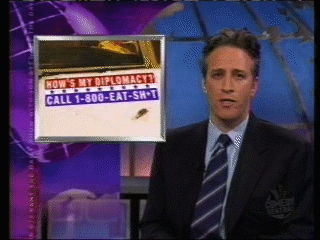
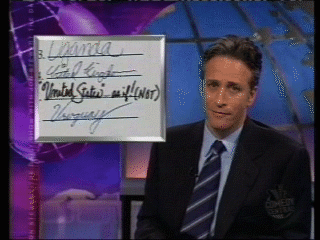


The Daily Show -- the best news on television.
Update 12:43 pm: Hey guys, is there a transcript of this already available? Otherwise, I may have to transcribe this video...Let me know...
Okay so here's the official FCC video from yesterday's "Open Agenda" meeting at the FCC with Michael Powell.
More on what all of this means as soon as I can figure it out.
I just don't want to delay showing this to you since every minute counts at this point.
It looks like there are a number of hot items on the agenda...
So I'm watching it too...and I'll repost here with more specifics about where the non-boring parts are (when and if I get to them :-)
Thanks!
lisa
Estimated time: 3-7 minutes.
It took me about ten minutes, but I didn't already have the two things to say below written for me -- like you do -- and I also had to wait on hold for a couple minutes listening to classical music because the line was busy.
Please look up your Senators and then use my really simple talking points (below) or pehaps some of the more detailed talking points (with resources) that some folks were nice enough to put together.
I called up Barbara Boxer (I can't bring myself to contact Feinstein) and left a message that:
1) I am very concerned about the proposed changes in the FCCs media ownersip rules.
and
2) To please do everything in her power to demand another official public hearing regarding the details of the changes before any kind of final ruling can be made.
(Thanks to Michelle Wolf and Alison Brzencheck and anyone else I forget to mention that helped write and distribute the information below before it found its way to me.)
Hi All,
Moveon.org is facilitating a national call in campaign to coincide with the
FCC's meeting today. They are asking all Americans concerned about the
state of the mass media to phone there state legislators to express their
concern (see note below). I have attached a PDF of the numbers for the
senate and the House of Representatives.
For individuals that do not feel they have enough knowledge of the issues,
I have provided talking points at the bottom of this email for them to use
in the call.
Thanks,
Alison Brzenchek
Vice President of Media Reform
Action Coalition for Media Education Board of Directors
____________________________________________________________________
Hi all,
I'm really sorry for the late notice but it's been decided
that the call in day is tomorrow/today Thursday May 15th to
coincide with the FCC's meeting.
MoveOn will send out the call late tonight/early morning
to ask folks to call their Congresspeople asap. Please
forward on to your lists and let's make sure our elected
officials in DC hear us (and the NRA :)
Word is that MoveOn got over 150,000 people to sign their
petition last week, and all of those folks will be emailed
to make a call tomorrow.
We should discuss as a group whether we want to build for
another call-in day closer to the FCC's vote.
Let's burn up those phone lines and keep the momentum
building!
jeffp
____________________________________________________________________
Talking Points
1. I am aware of the letters you have received from legislators:
There was a letter sent from Senate Commerce Committee members Allard,
Snowe and Collins to Chairman Powell.
The letter urged Powell to publicly address how any changes in media
ownership rules "will promote diversity, competition, and localism" before
issuing a final ruling.
See more the letter at: http://www.acmecoalition.org/fcc1.html
2. I have been made aware of a poll done by the Project for Excellence in
Journalism and the Pew Research Center for the People and The Press that
asked:
"How much, if anything, have you heard about a Federal Communications
Commission proposal to reduce current limits on the number of news outlets
one company can own," the survey asked. "A lot, a little, or nothing at
all?"
72% of Americans have heard "nothing at all"
4% of Americans have heard "a lot."
Find out more at:
http://journalism.org/resources/research/reports/fccsurvey/default.asp
3. I am concerned that corporations are being prioritized over the public
welfare.
"Chairman Powell defines his job as promoting variety in the entertainment
market," said Mark Cooper, CFA's Director of Research, "but the First
Amendment is about ensuring vibrant civic discourse through diversity of
viewpoints and vigorous competition between institutions in the gathering
and dissemination of news and information."
4. I am familiar with the Supreme Courts 1945 decision on the First
Amendment. I believe that further elimination of media ownership
regulations is in conflict with this decision.
In 1945, the Supreme Court decided that "the widest possible dissemination
of information from diverse and antagonistic sources is essential to the
welfare of the public, that a free press is a condition of a free society."
See full case decision at:
http://www.usscplus.com/online/index.asp?case=3260001
5. I am aware of evidence that shows that eliminating media ownership
regulations will not support the diversity, localism and competition the
FCC is charged to protect.
A study by the Consumer Federation of America called, Democratic Discourse
in the Digital Information Age demonstrates that the FCC studies are asking
the wrong questions.
"They look at variety of entertainment when they should be looking at
diversity of information."
"They worry about number of outlets when strength of journalistic
institutions is what matters."
"They downplay the key role of concentration of ownership, and they ignore
the size and diversity of the population served by the media."
See the Executive Summary at:
http://www.consumerfed.org/demodiscoursesum.pdf
6. I am aware of differing opinions within the commission. Additionally, I
am concerned that the Chair of the Commission (Powell) has only held one
"offical" public hearing and has only participated in one "unofficial"
hearing spearheaded by Commissioner Copps.
There have been 4 unofficial hearings through out the US and Powell only
attend 1
There are four additional unofficial hearing scheduled between now and May
7th
"If you take this to its logical conclusion, you could end up with a
situation where one company owns the newspaper, the television station, the
radio station and the cable system. That may have some economic
efficiencies attached to it, but I daresay it also has some profound
democratic and social and political considerations that we ignore only at
our own tremendous peril."(Statement made by Commissioner Copps in an
interview with Bill Moyers on NOW, 2002)
7. I am extremely concerned because the majority of television, newspaper
and cable broadcasters are not covering this extremely important issue.
We do not hear about ownership issues in the mainstream media due to the
financial benefits that the owners stand to gain with further deregulation.
------ End of Forwarded Message
Hey guys - there's already a small version of this up that I just screwed up the code for earlier...Sorry 'bout that...Next Time -- let me know if something like this happens...okay guys? :-)
Here's the Daily Show's take on the story I just blogged about last week's big Wall St. Fraud payoff.
Daily Show On Wall St. Payoff - 4-29-03 (Small - 4 MB)
No high res available at this time :-(
Daily Show On Wall St. Payoff - 4-29-03 (Hi-Res - 47 MB) -->

The Daily Show -- the best news on television.
Okay so something has come up (family thing--nothing terrible :) and now I'm not sure if I'm going to get video up before I have to leave at noon. So I thought I would at least share some images from yesterday while they are still fresh in my mind.
Last night's march was a huge success. The whole thing was peaceful and the cops didn't even have their riot gear out. (They sure had a lot of cameras going though!)
The Chief of Oakland Police even came out to say "hi." Okay, he didn't actually come out and say "hi". Several people recognized him, but he just looked at us from inside his men-in-black looking car while we all said "hello" and smiled and waved.
It sure was a long walk to the docks from the West Oakland Bart station, and I gotta start remembering to always wear my walking shoes to these events. Of course, it could have seemed longer because I had a coat on that I didn't need (with the sun shining so bright and all). I was also carrying my camera and tripod the whole time, and they got progressively heavier as time passed along.
Once we had secured all of the docks (and "secured" just means that there was a little picket circle of people out in front that would politely ask drivers of cars and trucks coming up to the gate to please turn around -- and yes, they were all turning around, from what I could see), we walked clear from one end of the docks to the other -- apparently with the blessings of a police escort the entire time. At that point, things felt stable enough for me to go home.
Luckily, a VW bus of cheerful older ladies gave me a ride back to the Bart station. I can't believe I didn't get a picture of them -- I must have been too exhausted from being in the sun too long. Hopefully I'll see them at another protest soon and can get a snapshot then. They were a cheerful bunch. The youngest one must of been at least 65, and they said they had been there for most of the afternoon and they had been doing stuff like this for over 60 years. How cool!
I promise I'll have video up in a day or two! Hope this gives you a feel for what happened 'till you can see for yourself!
As of approximately 6:40 pm, all was well over at the Oakland Dock protest.
I'll have footage up of it tomorrow.
Peace.
So there's another peaceful, non-civil disobedient rally going on today at the West Oakland Docks.
Just go to West Oakland Bart and look for the people and signs.
If you're in the SF Bay Area, try to come by. It's going on from 5-9 pm.
I'll be there for the first hour or two...
Or go about your business, and I"ll have footage of it up tomorrow morning :-)
I'm bringing my health care card with me, in case the Cops open fire with rubber bullets for no reason again (eleven more articles on this), and I end up in the hospital.
(Boy, that's kind of a reassuring/creepy feeling...)
Michael Franti and Radio performed for over an hour on Saturday afternoon at the "Mothers Day - Speak Out For Peace Concert" in Golden Gate Park last weekend.
Here are "We Don't Stop" and "Feeling Free/What's Goin On" (Franti's "Feeling Free" with the famous "What's Goin On" in the middle of it). It's kinda long, so, for those of you who would like to hear the Issac Hayes cover, but don't want to wait for it, I've created an "What's Goin On - Extended Version" that only contains the last two thirds of the song (it stands up great on its own, actually.)
Please let me know which mixes you like best.
Special Thanks to Michael Franti for giving me a badly needed dose of hope, energy and rejuvination over the weekend!
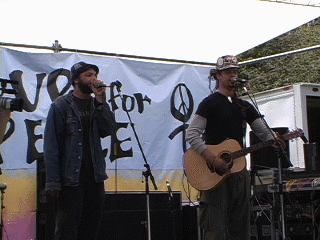
Michael Franti and Radio - We Don't Stop - Live In Golden Gate Park
Michael Franti and Radio - We Don't Stop - Live (Small - 10 MB)
Michael Franti and Radio - We Don't Stop - Live (Hi-Res - 118 MB)
Audio - Michael Franti and Radio - We Don't Stop - Live (MP3 - 4 MB)
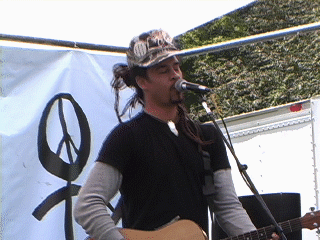
Michael Franti and Radio - Feeling Free/What's Going On - Live In Golden Gate Park - Complete Version
Michael Franti and Radio - Feeling Free/What's Going On - Complete (Small - 24 MB)
Hi-res currently unavailable -- too big!
Audio - Michael Franti and Radio - Feeling Free/What's Going On - Complete (MP3 - 10 MB)
Michael Franti and Radio - What's Going On - Extended version - Live In Golden Gate Park
Michael Franti and Radio - What's Going On - Extended version (Small - 14 MB)
Michael Franti and Radio - What's Going On - Extended version (Hi-Res - 73 MB)
Audio - Michael Franti and Radio - What's Going On - Extended version (MP3 - 7 MB)
Michael Franti had a little heart to heart talk with the audience in-between songs during Saturday's "Mothers Day Speak Out For Peace" Concert In San Francisco's Golden Gate Park last weekend.
(Near-complete transcription available below.)
Michael Franti on May 10, 2003 - Complete
Michael Franti on May 10, 2003 - Words - Complete (Small - 10 MB)
Michael Franti on May 10, 2003 - Words - Complete (Hi-Res - 149 MB)
Audio - Michael Franti on May 10, 2003 - Words - Complete (MP3 - 5 MB)
Press and others that just need a short clip of "some good stuff" from Franti's talk.
I've created "edited" versions:
Michael Franti on May 10, 2003 - Edited version (First half.)
Michael Franti on May 10, 2003 - Words - Edited (Small - 5 MB)
Michael Franti on May 10, 2003 - Words - Edited (Hi-Res - 59 MB)
Audio - Michael Franti on May 10, 2003 - Words - Edited (MP3 - 2 MB)
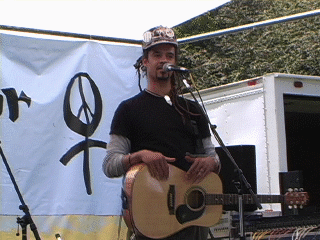
Martin Luther King says that "peace" is not merely the absence of war, but it's the presence of justice.And now, we've invaded Iraq, and, at best, it's just good old fashioned colonialism. You invade a country. We use its people. We use its resources, and we occupy the nation. At worst, it could turn into the next Palestine. It could turn into the next Berlin. They're talking about possibly dividing up Iraq into three separate portions -- dividing up the people by ethnic groups and ruling it militarily.
They've suggested this man "Kabala" to run the nation, and he was busted for stealing 200 million dollars from the people of Jordan, because he was running these illegal banks in Jordan, and he's the guy who Tommy Franks says "That's our guy!" He seems qualified. He was sentenced to 22 years in prison, and he escaped and went and lived in England for a while. And now he's back.
So, President Bush spends a billion dollars to go have a little tea party on this aircraft carrier and pose for a lot of pictures. And they say, "Well, things are gonna be different. We've liberated the people of Iraq." And I look around here in San Francisco. I see people holding up signs on the street corner that say "I'm a U.S. Veteran. Please give me change." And they've spent 76 Billion dollars of our change to fight this war in Iraq, but they can't take care of Veterans back home.
And it's been a big challenge to me in my heart to think, that now, those of us who have been setting up food stands and coming out to events like this for years and years, are going to now have to have bake sales and put on concerts to send money to support the people of Iraq. And I have a lot of ambivalence about that. And it's a very difficult time right now. It's a big challenge for all of us to find continued love in our hearts. And, I just want you to know that we're all in this together, and that as long as a few of us like this can hold on to hope, there's still hope in the world.
Yep. That's me singing harmonies and my buddy Audrey Howard on guitar and lead vocals.
Lisa Rein and Audrey Howard - Life During Wartime (Small - 8 MB)
Lisa Rein and Audrey Howard - Life During Wartime (Hi-Res - 132 MB)
Audio - Lisa Rein and Audrey Howard - Life During Wartime (MP3 - 3 MB)
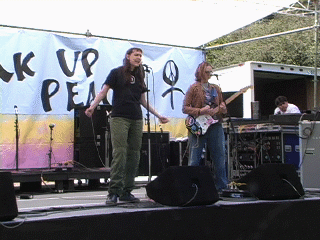
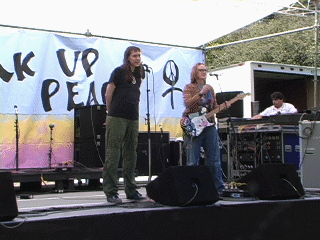
Today at 1pm there will be a big peace concert in the park.
(Complete music schedule below.)
I'll be singing a really short song around 12:30 pm with my friend Audrey Howard.
(We're doing harmonies on a cover of Green Day's Life During Wartime.)
It would be great to have a big turn out for this thing.
I will be video taping portions of it, and audio recording the whole thing.
DJ Praxis will be holding it together all day - MP3 of "dem bonez" -- and most likely spinning while the sun sets after the main show is over.
Michael Franti (Spearhead) goes on at 2:30 pm.
Free Peoples is headlining, and they go on around 4:30 pm.
Here's more about them:
Free Peoples is a Bay Area-based band playing a style fusing bluegrass, folk and jazz. The members come from various projects local to Los Angeles and San Francisco, most notably, Trichromes, Buzz, Spirit Level and Top Four Flights. Tim Sawyer is on lead vocals and Guitar. Johnny Downer plays lead guitar and vocals. Michael DiPirro is on bass and vocals.Special Guest on Free Peoples new self titled cd includes; Tony Trischka on banjo, Tom Rozum on Mandolin, David Phillips on Dobro and Chad Clouse on fiddle.
Mike D can also be seen with his other project, The Trichromes, featuring Billy Kreutzmann of the Grateful Dead.
(Complete music schedule below.)
Directions
Public Transit: 5 Fulton to 30th Avenue. It is a very short downhill block to J.F.K.
Drive and you're there!
If you are driving the park is open for traffic west of 19th Avenue and it
is easiest to find the meadow if you enter from Fulton St. and 30th Avenue.
Complete Music Schedule
12:30 pm Lisa Rein and Audrey Howard (like if you blink, you'll miss us :-)
12:45 pm Ara Avakian (singer/songwriter) &
Eric Hellweg (singer/songwriter)
1:00 pm DJ Praxis
1:20 pm Irina and MNO - World Music Meets Electronica Laptops + live
1:40 pm Pushing Destinations hip-hop
2:00 pm Andrea Pritchett
2:30 pm Michael Franti
3:00 pm Red Guard
3:35 pm Raz K’dee
3:50 pm Deep (Hip Hop)
4:05 pm Shailja Patel (South Asian Spoken word)
4:20 pm Samantha Hynes (Student from Oakland High School)
4:35 pm Free Peoples bluegrass/folk/jazz mix
Here is complete audio and video footage of the Warblogging panel at Etech 2003.
This panel was hosted by Boing Boing's Xeni Jardin and included: Doc Searls, Dan Gillmor, Technorati's David Sifry and BBC News Producer and warblogger Stuart Hughes calling in from England
There's web-sized video in two parts and three parts, and MP3s of the audio in three parts.
This was easily one of the week's most riveting panels.
In Two Parts (larger file sizes):
Warblogging Panel At Etech 2003 - Part 1 of 2 (Small - 54 MB)
Warblogging Panel At Etech 2003 - Part 2 of 2 (Small - 60 MB)
In Three Parts:
Warblogging Panel At Etech 2003 - Part 1 of 3 (Small - 32 MB)
Warblogging Panel At Etech 2003 - Part 2 of 3 (Small - 43 MB)
Warblogging Panel At Etech 2003 - Part 3 of 3 (Small - 39 MB)
Audio - Warblogging Panel At Etech 2003 - Part 1 of 3 (MP3 - 21 MB)
Audio - Warblogging Panel At Etech 2003 - Part 2 of 3 (MP3 - 26 MB)
Audio - Warblogging Panel At Etech 2003 - Part 3 of 3 (MP3 - 23 MB)
Descriptions go with the photo directly below them.
Xeni Jardin
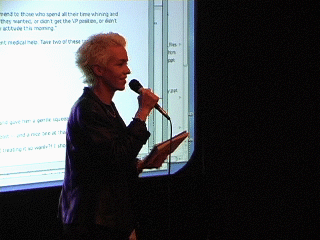
Stuart Hughes (from England via Telephone)
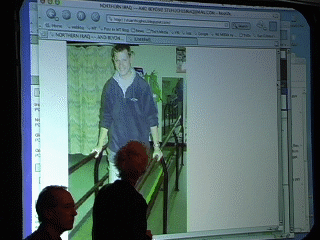
Crowd Shot (Jesse, Steve Jensen - middle, Kevin Burton - far right)
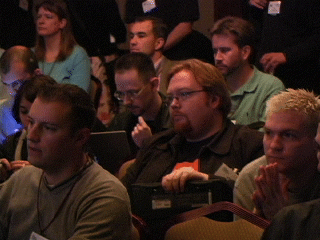
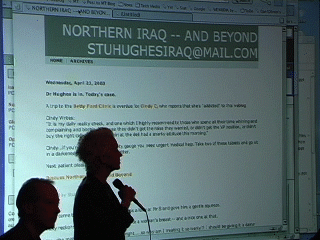
Stuart Hughes (from England via Telephone)
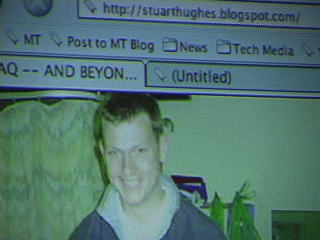
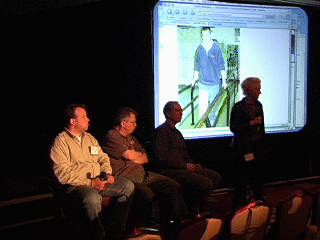
Doc Searls (left), Dan Gillmor
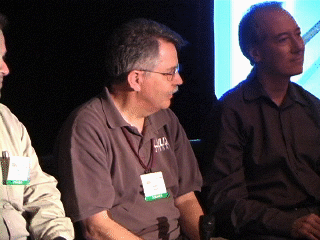
Doc Searls
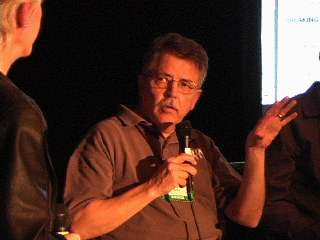
Crowd shot. (Robert Kaye and Joey deVilla in the middle there.)
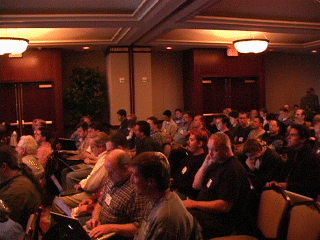
Pensive Xeni

Happy Xeni
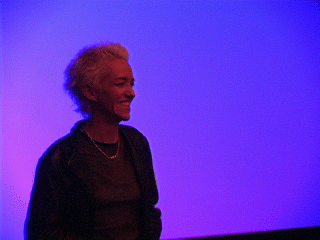
David Sifry
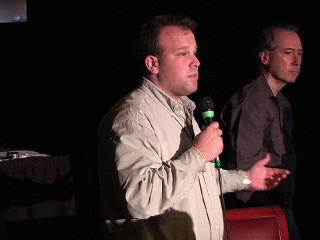

This work is dedicated to the
Public Domain. (Take it and run, baby!)
Two Killed In New Iraq Demo Shooting
By Chris Hughes In Al-Fallujah with Pictures by Julian Andrews for The Mirror.
I watched in horror as American troops opened fire on a crowd of 1,000 unarmed people here yesterday.Many, including children, were cut down by a 20-second burst of automatic gunfire during a demonstration against the killing of 13 protesters at the Al-Kaahd school on Monday...
A machine gun post at one of the corners swivelled round, taking aim at the crowd which pulled to a halt.
We heard no warning to disperse and saw no guns or knives among the Iraqis whose religious and tribal leaders kept shouting through loud hailers to remain peaceful. In the baking heat and with the deafening noise of helicopters the tension reached breaking point.
Julian and I ran towards the compound to get away from the crowd as dozens of troops started taking aim at them, others peering at them through binoculars.
Tribal leaders struggled to contain the mob which was reaching a frenzy.
A dozen ran through the cordon of elders, several hurling what appeared to be rocks at troops.
Some of the stones just reached the compound walls. Many threw sandals - a popular Iraqi insult.
A convoy of Bradley military jeeps passed by, the Iraqis hurling insults at them, slapping the sides of the vehicles with their sandals, tribal leaders begging them to retreat.
The main body of demonstrators jeered the passing US troops pointing their thumbs down to mock them.
Then came the gunfire - and the death and the agony.
After the shootings the American soldiers looked at the appalling scene through their binoculars and set up new positions, still training their guns at us.
An angry mob battered an Arab TV crew van, pulling out recording equipment and hurling it at the compound. Those left standing - now apparently insane with anger - ran at the fortress battering its walls with their fists. Many had tears pouring down their faces.
Still no shots from the Iraqis and still no sign of the man with the AK47 who the US later claimed had let off a shot at the convoy.
http://www.mirror.co.uk/news/allnews/page.cfm?objectid=12908278&method=full&siteid=50143&headline=TWO%20KILLED%20IN%20NEW%20IRAQ%20DEMO%20SHOOTING
TWO KILLED IN NEW IRAQ DEMO SHOOTING
May 1 2003
From Chris Hughes In Al-Fallujah. Pictures by Julian Andrews
IT started when a young boy hurled a sandal at a US jeep - it ended with two Iraqis dead and 16 seriously injured.
I watched in horror as American troops opened fire on a crowd of 1,000 unarmed people here yesterday.
Many, including children, were cut down by a 20-second burst of automatic gunfire during a demonstration against the killing of 13 protesters at the Al-Kaahd school on Monday.
FIRST SHOTS: Soldier opens fire on crowd yesterday
They had been whipped into a frenzy by religious leaders. The crowd were facing down a military compound of tanks and machine-gun posts.
The youngster had apparently lobbed his shoe at the jeep - with a M2 heavy machine gun post on the back - as it drove past in a convoy of other vehicles.
A soldier operating the weapon suddenly ducked, raised it on its pivot then pressed his thumb on the trigger.
Mirror photographer Julian Andrews and I were standing about six feet from the vehicle when the first shots rang out, without warning.
We dived for cover under the compound wall as troops within the crowd opened fire. The convoy accelerated away from the scene.
Iraqis in the line of fire dived for cover, hugging the dust to escape being hit.
We could hear the bullets screaming over our heads. Explosions of sand erupted from the ground - if the rounds failed to hit a demonstrator first. Seconds later the shooting stopped and the screaming and wailing began.
One of the dead, a young man, lay face up, half his head missing, first black blood, then red spilling into the dirt.
MAYHEM: Iarqis run for cover and others dive to the ground to escape bullets
His friends screamed at us in anger, then looked at the grim sight in disbelief.
A boy of 11 lay shouting in agony before being carted off in a car to a hospital already jam-packed with Iraqis hurt in Monday's incident.
Cars pulled up like taxis to take the dead and injured to hospital, as if they had been waiting for this to happen.
A man dressed like a sheik took off his headcloth to wave and direct traffic around the injured. The sickening scenes of death and pain were the culmination of a day of tension in Al-Fallujah sparked by Monday's killings.
The baying crowd had marched 500 yards from the school to a local Ba'ath party HQ. We joined them, asking questions and taking pictures, as Apache helicopters circled above.
The crowd waved their fists at the gunships angrily and shouted: "Go home America, go home America."
We rounded a corner and saw edgy-looking soldiers lined up along the street in between a dozen armoured vehicles. All of them had automatic weapons pointing in the firing position.
As the crowd - 10 deep and about 100 yards long - marched towards the US positions, chanting "Allah is great, go home Americans", the troops reversed into the compound.
On the roof of the two-storey fortress, ringed by a seven-foot high brick wall, razor wire and with several tanks inside, around 20 soldiers ran to the edge and took up positions.
TRAGEDY: Shot man lies dead in the street as blood pours from his head wound
A machine gun post at one of the corners swivelled round, taking aim at the crowd which pulled to a halt.
We heard no warning to disperse and saw no guns or knives among the Iraqis whose religious and tribal leaders kept shouting through loud hailers to remain peaceful. In the baking heat and with the deafening noise of helicopters the tension reached breaking point.
Julian and I ran towards the compound to get away from the crowd as dozens of troops started taking aim at them, others peering at them through binoculars.
Tribal leaders struggled to contain the mob which was reaching a frenzy.
A dozen ran through the cordon of elders, several hurling what appeared to be rocks at troops.
Some of the stones just reached the compound walls. Many threw sandals - a popular Iraqi insult.
A convoy of Bradley military jeeps passed by, the Iraqis hurling insults at them, slapping the sides of the vehicles with their sandals, tribal leaders begging them to retreat.
The main body of demonstrators jeered the passing US troops pointing their thumbs down to mock them.
Then came the gunfire - and the death and the agony.
After the shootings the American soldiers looked at the appalling scene through their binoculars and set up new positions, still training their guns at us.
An angry mob battered an Arab TV crew van, pulling out recording equipment and hurling it at the compound. Those left standing - now apparently insane with anger - ran at the fortress battering its walls with their fists. Many had tears pouring down their faces.
Still no shots from the Iraqis and still no sign of the man with the AK47 who the US later claimed had let off a shot at the convoy.
I counted at least four or five soldiers with binoculars staring at the crowd for weapons but we saw no guns amongst the injured or dropped on the ground.
A local told us the crowd would turn on foreigners so we left and went to the hospital.
There, half an hour later, another chanting mob was carrying an open coffin of one of the dead, chanting "Islam, Islam, Islam, death to the Americans".
We left when we were spat at by a wailing woman dressed in black robes.
US troops had been accused of a bloody massacre over the killings of the 13 Iraqis outside the school on Monday. Three of the dead were said to be boys under 11.
At least 75 locals were injured in a 30-minute gun battle after soldiers claimed they were shot at by protesters.
Demonstrators claimed they were trying to reclaim the school from the Americans who had occupied it as a military HQ.
The crowd had defied a night-time curfew to carry out the protest.
I'll be talking about this all week long because I'm helping out a bit to organize the event. Do me a big favor and SHOW UP if you're in town, ok? It might even be worth making a trip for, if all works out like I think it's going to...
Michael Franti (Spearhead) will be performing!
(Download Spearhead's new single there, "Bomb the World"!)
We still haven't gotten all of the confirmations in yet, so I can't say yet who else might be playing. (And there may still be room in the lineup for you too -- if you've got only a song or two and minimal setup requirements :-)
Here's the "official" info so far (including an ever-growing list of all the organizations supporting this event):
Mother's Day SPEAK UP for PEACE
A multi-cultural Mother's Day program of music, poetry, dance and personal
testimony about the war and the path to world peace.
Saturday May 10 in Golden Gate Park. San Francisco
1-5PM
BRING OUR SONS AND DAUGHTERS HOME NOW
ANOTHER WORLD IS POSSIBLE
US OUT OF IRAQ
As Bush prepares to state officially that the war in Iraq is over, we must continue our effort to promote peace and kinship among people at home & around the world as the solution to international conflicts, Not military aggression. Equally we must stand up for our communities and remind our leaders that we will not be distracted from the crises at home by continuous crises abroad.
All over the world, mothers represent creation and nurturing. In the spirit of Mother's Day, we are calling on mothers and other members of our community to speak out against war and in favor of peace.
We are putting together a great program for a great day in the park with music culture and personal testimony
to celebrate Mother's Day and to nourish us all for the struggle ahead. PLEASE CONSIDER BEING A PART OF THE DAY! & RSVP Quickly
For Mother's Day - SPEAK UP for PEACE
Bring our sons and daughters home now!
Another world is possible.
US out of Iraq!
On Saturday, May 10th, beginning at 1:00 p.m., a broad coalition of peace and social justice organizations will sponsor a Speak Up for Peace rally and cultural celebration in Lindley Meadow in Golden Gate Park (off JFK Drive).
A diverse group of people who have been deeply and personally affected by the war in Iraq will make short statements. Music and spoken word culture will be provided by renowned artists such as Michael Franti, Diskart Namin, Andrea Pritchard and many more. This family-friendly gathering is free, though contributions will be greatly appreciated.
Sponsors:
A Jewish Voice for Peace, Bay Area United Against War, Code Pink,
Not in Our Name, United for Peace & Justice,
Endorsers:
American Friends Service Committee SF
Bethany United Methodist Church
California Peace Action
Campus Anti-War Network
Catholics for Peace
Chinese Progressive Association
Coffee House Teach-In's
Committees of Correspondence for Democracy and Socialism
Companeros del Barrio
Filipinos for Global Justice not War Coalition
Freedom Socialist Party
Global Exchange
Harvey Milk Lesbian,Gay,Bisexual & Transexual Democratic Club
International ANSWER
Labor Committee for Peace and Justice
Out Against the War
Peace and Freedom Party
Pride at Work, AFL-CIO
Radical Women
SF Labor Council,
AFL-CIO
Socialist Action
Socialist Organizer
Socialist Viewpoint Magazine
US Labor Against War
Vanguard Foundation
and many more
For more information: (JVP) 510 465 1777 (BAUAW) 415-824-8730; (Code Pink) 415-575-5555; (UfPJ) 415-565-0201; (NION) 510-444-NION
This just in on the AP wire:
Closed-Door McCarthy Transcripts Unsealed
The transcripts themselves are available at:
http://govt-aff.senate.gov/psi.htm
The senators who oversaw the project, Susan Collins, R-Maine, and Carl Levin, D-Mich., unveiled the transcripts Monday in the very room that McCarthy used to hold some of his hearings.``We hope that the excesses of McCarthyism will serve as a cautionary tale for future generations,'' Collins said. Levin recalled organizing an anti-McCarthy petition as a student at Swarthmore College.
Senate Associate Historian Donald Ritchie, who assembled the volumes, said McCarthy and his chief counsel, Roy Cohn, used the closed-door sessions like grand jury proceedings.
``Anybody who stood up to McCarthy in closed session, and did so articulately, tended not to get called up into the public session,'' Ritchie said. ``McCarthy was only interested in the people he could browbeat publicly.''
Copland, brought before the subcommittee because he had been hired by the State Department to lecture overseas, was one of those never called back for a public session.
When McCarthy asked whether he had ever been a communist sympathizer, Copland replied, ``I am not sure I would be able to say what you mean by the word 'sympathizer.'''
...McCarthy was angered when Eslanda Goode Robeson cited the 15th Amendment, which gave blacks the right to vote, as well as the Fifth Amendment in refusing to answer whether she was a member of the Communist Party.
``The 15th Amendment has nothing to do with it,'' said McCarthy.
Robeson replied: ``(Y)ou see, I am a second-class citizen in this country and, therefore, feel the need of the 15th. ... I am not quite equal to the rest of the white people.''
Robeson finally said a truthful answer would incriminate her. McCarthy brought her back to testify in public.
``McCarthy thrived on the Fifth Amendment,'' Oshinsky said. ``He liked nothing better than to ask people very pointed questions, and they would take the Fifth, so he could call them 'Fifth Amendment communists' and talk about a larger conspiracy.''
Here is the full text of the article in case the link goes bad:
http://nytimes.com/aponline/national/AP-McCarthy-Hearings.html
The New York Times A.P. Index May 5, 2003
Closed-Door McCarthy Transcripts Unsealed
By THE ASSOCIATED PRESS
Filed at 11:29 a.m. ET
WASHINGTON (AP) -- Pushing an anti-communist crusade that riveted America a half century ago, Joseph McCarthy manipulated his Senate hearings by calling witnesses he could intimidate and ignoring those likely to oppose him, newly released transcripts show.
Among the nearly 500 witnesses covered in transcripts of closed door meetings, made public Monday by the Senate, are composer Aaron Copland, New York Times journalist James Reston and Eslanda Goode Robeson, the wife of blacklisted singer-actor Paul Robeson. Some 4,000 pages of newly released documents also show that McCarthy was convinced that many writers, government officials and secretaries had access to classified information.
McCarthy, a Wisconsin Republican, chaired the Senate Permanent Subcommittee on Investigations in 1953 and 1954 at the height of the Cold War with the Soviet Union. His investigation into communists in the U.S. government, denounced by critics as a witch hunt, spawned the term ``McCarthyism'' to describe smear attacks.
The senators who oversaw the project, Susan Collins, R-Maine, and Carl Levin, D-Mich., unveiled the transcripts Monday in the very room that McCarthy used to hold some of his hearings.
``We hope that the excesses of McCarthyism will serve as a cautionary tale for future generations,'' Collins said. Levin recalled organizing an anti-McCarthy petition as a student at Swarthmore College.
Senate Associate Historian Donald Ritchie, who assembled the volumes, said McCarthy and his chief counsel, Roy Cohn, used the closed-door sessions like grand jury proceedings.
``Anybody who stood up to McCarthy in closed session, and did so articulately, tended not to get called up into the public session,'' Ritchie said. ``McCarthy was only interested in the people he could browbeat publicly.''
Copland, brought before the subcommittee because he had been hired by the State Department to lecture overseas, was one of those never called back for a public session.
When McCarthy asked whether he had ever been a communist sympathizer, Copland replied, ``I am not sure I would be able to say what you mean by the word 'sympathizer.'''
``These executive sessions are really trolling sessions,'' said David M. Oshinsky, author of a McCarthy biography, ``A Conspiracy So Immense,'' and a history professor at the University of Texas.
``McCarthy is looking for people who either have a spectacular story to tell, or people he thinks he can break in public, or people he was certain will take the Fifth Amendment'' against self-incrimination, Oshinsky said.
McCarthy was angered when Eslanda Goode Robeson cited the 15th Amendment, which gave blacks the right to vote, as well as the Fifth Amendment in refusing to answer whether she was a member of the Communist Party.
``The 15th Amendment has nothing to do with it,'' said McCarthy.
Robeson replied: ``(Y)ou see, I am a second-class citizen in this country and, therefore, feel the need of the 15th. ... I am not quite equal to the rest of the white people.''
Robeson finally said a truthful answer would incriminate her. McCarthy brought her back to testify in public.
``McCarthy thrived on the Fifth Amendment,'' Oshinsky said. ``He liked nothing better than to ask people very pointed questions, and they would take the Fifth, so he could call them 'Fifth Amendment communists' and talk about a larger conspiracy.''
The tide began to turn against McCarthy in 1954, when he looked for subversives in the Army. President Eisenhower, a retired Army general, worked to get the hearings televised so the public could see McCarthy's bullying tactics, Oshinsky said.
Minnesota Sen. Norm Coleman, a freshman Republican who chairs the Senate Permanent Subcommittee on Investigations, said in a statement that McCarthy had ``an obligation to use his authority in a way to make America safer, and determine the influence of communism, if it existed, in American policy.''
``Instead, he used his position to threaten, to intimidate and to destroy the lives of Americans,'' Coleman said.
The volumes show McCarthy often held hearings in New York City and Boston, subpoenaing witnesses on short notice, and would be the only senator to attend.
Sometimes even McCarthy wouldn't attend, Ritchie said. The 26-year-old Cohn would question witnesses, and his buddy, G. David Schine, who served as unpaid consultant to the committee, would preside. Cohn addressed Schine as ``Mr. Chairman.''
Oshinsky said communists had indeed infiltrated the government during the 1930s and 1940s, but by the time McCarthy launched his investigation that had pretty much been stamped out.
Still, Republicans succeeded in portraying Democrats as soft on communism, riding that message to political gains in 1952. The GOP won the White House and Congress that year, making McCarthy chairman of the investigations subcommittee.
McCarthy continued hunting for communists in the State Department, Voice of America, U.S. overseas libraries, Government Printing Office and Army Signal Corps. Republicans began to turn on him when he set his sights on the Eisenhower administration.
The Senate censured McCarthy in December 1954, and he lost his chairmanship the following month after Democrats regained the majority. Discredited and broken, McCarthy died in 1957 at 47.
That same year, the Supreme Court ruled that witnesses don't lose their constitutional rights when they testify in a congressional investigation. Some historians say that ruling is McCarthy's most important legacy.
^------
On the Net:
The transcripts are available at: http://govt-aff.senate.gov/psi.ht
This isn't only unfortunate, I believe it's illegal. Unless all of the FCC safety precautions have been de-regulated along with everything else.
I would so love to publish more details about how 1) this was able to happen and
2) what steps Clear Channel has taken to see that it never happens again.
If Clear Channel isn't doing everything in its power to convince the FCC that it's revising whatever policy it needs to so that someone is always on-hand to answer the telephone, it seems to me that the company has clearly demonstrated reckless disregard for the safety of people living in the "markets" it owns.
Anyone in the Minot, North Dakota area that's interested in working with me on this?
Why Worry About Who Owns The Media?
It's like something out of a nightmare, but it really happened: At 1:30 on a cold January night, a train containing hundreds of thousands of gallons of toxic ammonia derails in Minot, North Dakota. Town officials try to sound the emergency alert system, but it isn't working. Desperate to warn townspeople about the poisonous white cloud bearing down on them, the officials call their local radio stations. But no one answers any of the phones for an hour and a half. According to the New York Times, three hundred people are hospitalized, some are partially blinded, and pets and livestock are killed.Where were Minot's DJs on January 18th, 2002? Where was the late night station crew? As it turns out, six of the seven local radio stations had recently been purchased by Clear Channel Communications, a radio giant with over 1,200 stations nationwide. Economies of scale dictated that most of the local staff be cut: Minot stations ran more or less on auto pilot, the programming largely dictated from further up the Clear Channel food chain. No one answered the phone because hardly anyone worked at the stations any more; the songs played in Minot were the same as those played on Clear Channel stations across the Midwest.
Here is the full text of the entire article at:
http://www.moveon.org/moveonbulletin/bulletin12.html#1
MoveOn.org: Democracy in action.
SHOWDOWN AT THE FCC
MoveOn Bulletin
Friday, May 2, 2003
Co-Editors: Don Hazen and Lakshmi Chaudry, AlterNet
Subscribe online at: http://www.moveon.org/moveonbulletin/
CONTENTS:
1. Eli Pariser: Why Worry About Who Owns the Media?
2. Jeff Chester: Showdown at the FCC
3. Neil Hickey: The Gathering Storm Over Media Ownership
4. Bill Moyers: Barry Diller Takes On Media Deregulation
5. Danny Schechter: The Media, the War, and Our Right to Know
6. Eric Boehlert: Clear Channel's Big Stinking Deregulation Mess
7. Paul Schmelzer: The Death of Local News
8. Caryl Rivers: Where Have All the Women Gone?
9. About the Bulletin
------------------------------
WHY WORRY ABOUT WHO OWNS THE MEDIA?
MoveOn Bulletin Op-Ed
by Eli Pariser
It's like something out of a nightmare, but it really happened: At 1:30 on a cold January night, a train containing hundreds of thousands of gallons of toxic ammonia derails in Minot, North Dakota. Town officials try to sound the emergency alert system, but it isn't working. Desperate to warn townspeople about the poisonous white cloud bearing down on them, the officials call their local radio stations. But no one answers any of the phones for an hour and a half. According to the New York Times, three hundred people are hospitalized, some are partially blinded, and pets and livestock are killed.
Where were Minot's DJs on January 18th, 2002? Where was the late night station crew? As it turns out, six of the seven local radio stations had recently been purchased by Clear Channel Communications, a radio giant with over 1,200 stations nationwide. Economies of scale dictated that most of the local staff be cut: Minot stations ran more or less on auto pilot, the programming largely dictated from further up the Clear Channel food chain. No one answered the phone because hardly anyone worked at the stations any more; the songs played in Minot were the same as those played on Clear Channel stations across the Midwest.
Companies like Clear Channel argue that economies of scale allow them to cut costs while continuing to provide quality programming. But they do so at the expense of local coverage. It's not just about emergency warnings: media mergers are decreasing coverage of local political races, local small businesses, and local events. There are only a third as many owners of newspapers and TV stations as there were in the 1970s (about 600 now; over 1,500 then). It's harder and harder for Americans to find out what's going on in their own back yards.
On June 2, the Federal Communications Commission (FCC) is considering relaxing or getting rid of rules to allow much more media concentration. While the actual rule changes are under wraps, they could allow enormous changes in the American media environment. For example, one company could be allowed to own ABC, CBS, and NBC. Almost certainly, media companies will be allowed to own newspapers and TV stations in the same town. We could be entering a new era of media megaliths.
Do you want one or two big companies acting as gatekeepers and controlling your access to news and entertainment? Most of us don't. And the airwaves explicitly belong to us -- the American people. We allow media companies to use them in exchange for their assurance that they're serving the public interest, and it's the FCC's job to make sure that's so. For the future of American journalism, and for the preservation of a diverse and local media, we have the hold the FCC to its mission. Otherwise, Minot's nightmare may become our national reality.
------------------------------
Interested in taking on the FCC and other media-related concerns? Join the MoveOn Media Corps, a group of over 29,000 committed Americans working for a fair and balanced media. You can sign up now at:
http://www.moveon.org/mediacorps/
------------------------------
SHOWDOWN AT THE FCC
Jeffrey Chester and Don Hazen, AlterNet
Despite wide protests and the Clear Channel debacle, the FCC is about to award the nation's biggest media conglomerates a new give-away that will further concentrate media ownership in fewer hands. The impact on the American media landscape could be disastrous. Recent TV coverage of the Iraq war already illustrates that US media companies aren't interested in providing a serious range of analysis and debate. This overview describes what's at stake and offers an introduction to the following articles.
http://www.alternet.org/story.html?StoryID=15796
------------------------------
THE GATHERING STORM OVER MEDIA OWNERSHIP
Neil Hickey, Columbia Journalism Review
CJR's editor-at-large explains just what is at stake in this fight over media ownership. He provides an in-depth look at the issues, and major players in a battle that is pitting journalists against their bosses, breaking up old alliances, and gathering momentum as the day of reckoning draws near. He traces the snowballing trend of media consolidation and its implications for the future, revealing just how the drive for profit is eroding diversity, local control, and more importantly giving a few mega-corporations a monopoly over the dissemination of news.
http://www.alternet.org/story.html?StoryID=15654
------------------------------
BARRY DILLER TAKES ON MEDIA DEREGULATION
Bill Moyers, Now with Bill Moyers
The founder of Fox Broadcasting and present CEO of USA Networks is an unlikely but passionate opponent of plans to loosen media ownership rules. In an interview with Bill Moyers, the media mogul explains how deregulation creates corporations with "such overwhelming power in the marketplace that everyone has to do essentially what they say." Diller argues that government regulation is essential to prevent media companies from controlling everything we see, read, and hear. As he puts it, "Who else is gonna do it for us?"
http://www.alternet.org/story.html?StoryID=15768
------------------------------
THE MEDIA, THE WAR, AND OUR RIGHT TO KNOW
Danny Schechter, MediaChannel.org
Why did the media do such a poor job of reporting on the Iraq war? The boosterism of news anchors, the suppression of antiwar views, and the sanitized images of war that defined television coverage are not a simple matter of bias or ineptitude, says media analyst Danny Schechter. He draws attention to the connection between the decisions made by journalists and the lobbying efforts of owners who will profit immensely from the upcoming FCC decision in June.
http://www.mediachannel.org/views/dissector/moveon.shtml
------------------------------
CLEAR CHANNEL'S BIG STINKING DEREGULATION MESS
Eric Boehlert, Salon
Clear Channel, the radio and concert conglomerate, has been the greatest beneficiary of the 1996 Telecommunications Act, which stripped all ownership limits in the radio industry. The rapacious company, led by Bush supporter Lowry Mays, has grown from 40 stations to 1,225 since then, and now uses its power to routinely bully advertisers and record companies, and more recently censor antiwar artists. However, as Eric Boehlert points out, its "success" may be the most powerful weapon in the arsenal of media activists. Clear Channel's stranglehold on the radio industry is the best and clearest example of the effects of rampant deregulation.
http://www.alternet.org/story.html?StoryID=15281
------------------------------
THE DEATH OF LOCAL NEWS
Paul Schmelzer, AlterNet
Meet the Sinclair Broadcast Group, the "Clear Channel of local news." Since 1991, the company has managed to acquire 62 television stations or 24 percent of the national TV audience. The company's modus operandi is the centralized production of homogenized, repackaged faux "local" news. Its success offers an alarming glimpse of the post-deregulation world in which all news may be produced in one giant newsroom and from a single viewpoint -- which in Sinclair's case is wholeheartedly conservative.
http://www.alternet.org/story.html?StoryID=15718.
------------------------------
WHERE HAVE ALL THE WOMEN GONE?
Caryl Rivers, Women's Enews
Once the war on Iraq took center-stage in the headlines of newspapers and magazines across the country, women writers became increasingly rare in the media. In their place are mostly white men who write on a narrow band of foreign policy issues, mostly recycling their views over and over again. From the all-male line-ups in the op-ed pages of the Washington Post and the New York Times to the dwindling female bylines in the New Yorker and Atlantic Monthly, women's voices have been caught in a "spiral of silence" that is unprecedented since the pre-women's movement days.
http://www.alternet.org/story.html?StoryID=15677
------------------------------
ABOUT THE MOVEON BULLETIN AND MOVEON.ORG
The MoveOn Bulletin is a free email bulletin providing information, resources, news, and action ideas on important political issues. The full text of the MoveOn Bulletin is online at http://www.moveon.org/moveonbulletin/; you can subscribe to it at that address. The MoveOn Bulletin is a project of MoveOn.org.
MoveOn.org is an issue-oriented, nonpartisan, nonprofit organization that gives people a voice in shaping the laws that affect their lives. MoveOn.org engages people in the civic process, using the Internet to democratically determine a non-partisan agenda, raising public awareness of pressing issues, and coordinating grassroots advocacy campaigns to encourage sound public policies. You can help decide the direction of MoveOn.org by participating in the discussion forum at:
http://www.actionforum.com/forum/index.html?forum_id=223
About MoveOn.org Make a Donation Media Coverage Press Room Become a Volunteer
MoveOn and MoveOn.org are trademarks of MoveOn.org
This goes nicely with the article I just posted, where the Shrub Administration admits that a threat of WMDs wasn't ever really there.
U.S., U.K. Waged War on Iraq Because of Oil, Blair Adviser Says
By James Kirkup for Bloomberg.
The U.S. and U.K. went to war against Iraq because of the Middle East country's oil reserves, an adviser to British Prime Minister Tony Blair said.Sir Jonathan Porritt, head of the Sustainable Development Commission, which advises Blair's government on ecological issues, said the prospect of winning access to Iraqi oil was ``a very large factor'' in the allies' decision to attack Iraq in March.
``I don't think the war would have happened if Iraq didn't have the second-largest oil reserves in the world,'' Porritt said in a Sky News television interview.
Opponents of the war, including some members of Blair's Labour Party, have said that the conflict was aimed at securing Iraqi reserves to benefit Western economies and oil companies. U.S. and U.K. leaders have repeatedly rejected that, saying the war began because Iraq held illegal weapons and threatened other countries.
Here is the full text of the entire article in case the link goes bad:
http://quote.bloomberg.com/apps/news?pid=email&refer=top_world_news&sid=ahJS35XsmXGg
U.S., U.K. Waged War on Iraq Because of Oil, Blair Adviser Says
By James Kirkup
London, May 1 (Bloomberg) -- The U.S. and U.K. went to war against Iraq because of the Middle East country's oil reserves, an adviser to British Prime Minister Tony Blair said.
Sir Jonathan Porritt, head of the Sustainable Development Commission, which advises Blair's government on ecological issues, said the prospect of winning access to Iraqi oil was ``a very large factor'' in the allies' decision to attack Iraq in March.
``I don't think the war would have happened if Iraq didn't have the second-largest oil reserves in the world,'' Porritt said in a Sky News television interview.
Opponents of the war, including some members of Blair's Labour Party, have said that the conflict was aimed at securing Iraqi reserves to benefit Western economies and oil companies. U.S. and U.K. leaders have repeatedly rejected that, saying the war began because Iraq held illegal weapons and threatened other countries.
Blair has said he wants Iraqi oil revenues to be held in a United Nations-run trust fund and spent on rebuilding Iraq. Secretary of State Colin Powell said yesterday the U.S. may encourage Iraq to set up an oil revenue-sharing system that would distribute some proceeds from what he called the ``marvelous treasure'' to Iraqi citizens.
Oil production in Iraq was halted before the U.S.-led attack that toppled President Saddam Hussein. According to UN data, the nation is losing about $55 million a day in oil revenue as the U.S., the European Union and the Iraqi people debate postwar reconstruction plans.
Porritt's commission was set up in 2000 to advise the U.K. government on making economic and business activity compatible with environmental-protection policies. The body reports directly to Blair.
This isn't the first time Porritt has criticized the U.K. government. In October 2000, he said Blair and his ministers had failed to fulfill election promises on ecological issues.
Well this takes the cake: the Shrub Administration has admitted that there Saddam had no WMDs.
They must be feeling pretty confident about the outcome of the war to just come right out and say this.
Good news for Syria? If there are no WMDs in Iraq, then we can't follow them over the border into Syria. Right?
I'm looking for other articles with more details, but here's one from Neil McKay of the Sunday Herald to start you off with:
US: 'Saddam had no weapons of mass destruction'
Senior officials in the Bush administration have admitted that they would be 'amazed' if weapons of mass destruction (WMD) were found in Iraq.According to administration sources, Saddam shut down and destroyed large parts of his WMD programmes before the invasion of Iraq.
Ironically, the claims came as US President George Bush yesterday repeatedly justified the war as necessary to remove Iraq's chemical and biological arms which posed a direct threat to America.
Bush claimed: 'Saddam Hussein had weapons of mass destruction. We will find them.'
The comments from within the administration will add further weight to attacks on the Blair government by Labour backbenchers that there is no 'smoking gun' and that the war against Iraq -- which centred on claims that Saddam was a risk to Britain, America and the Middle East because of unconventional weapons -- was unjustified.
Here is the full text of the article in case the link goes bad:
http://www.sundayherald.com/33628
US: 'Saddam had no weapons of mass destruction'
By Neil Mackay
The Bush administration has admitted that Saddam Hussein probably had no weapons of mass destruction.
Senior officials in the Bush administration have admitted that they would be 'amazed' if weapons of mass destruction (WMD) were found in Iraq.
According to administration sources, Saddam shut down and destroyed large parts of his WMD programmes before the invasion of Iraq.
Ironically, the claims came as US President George Bush yesterday repeatedly justified the war as necessary to remove Iraq's chemical and biological arms which posed a direct threat to America.
Bush claimed: 'Saddam Hussein had weapons of mass destruction. We will find them.'
The comments from within the administration will add further weight to attacks on the Blair government by Labour backbenchers that there is no 'smoking gun' and that the war against Iraq -- which centred on claims that Saddam was a risk to Britain, America and the Middle East because of unconventional weapons -- was unjustified.
The senior US official added that America never expected to find a huge arsenal, arguing that the administration was more concerned about the ability of Saddam's scientists -- which he labelled the 'nuclear mujahidin' -- to develop WMDs when the crisis passed.
This represents a clearly dramatic shift in the definition of the Bush doctrine's central tenet -- the pre-emptive strike. Previously, according to Washington, a pre-emptive war could be waged against a hostile country with WMDs in order to protect American security.
Now, however, according to the US official, pre-emptive action is justified against a nation which simply has the ability to develop unconventional weapons.
right now for some reason. Try back in a few hours...
All fixed as of Sunday, May 4 at 6:00 am PST...
Here's another clip from Channel 2 News in San Francisco. This time the subject is investor fraud.
All the news reports are saying this huge settlement will "change the face of Wall Street," but I don't see why it will change anything. It seems like the rich have been allowed to buy their way out of going to jail again.
We're not talking about little firms here: we're talking about "old school" businesses that should have known better.
(Check out the list of offenders below.)
Apparently, Jon Stewart of the Daily Show felt the same way.
Wall St. Fraud Pay Off - KTVU - Channel 2 News 4-28-03 (Small - 8 MB)
Wall St. Fraud Pay Off - KTVU - Channel 2 News 4-28-03 (Hi-Res - 118 MB)
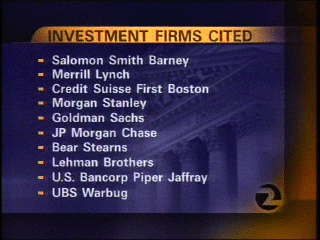
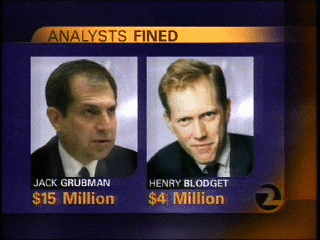
This is a clip from my local San Francisco news station KTVU, from last Monday night.
(Many apologies for the late turn around - I am swamped people! Swamped!)
Lawrence Lessig is helping Congresswoman Zoe Lofgren to spread the word about the launch of her new anti-spam bill, The Reduced Spam Act of 2003.
The bill would protect a business's right to send correspondence to its existing customer base, while providing a cash bounty to users-at-large who are the first to report spam.
More on this in the days to come -- as you can see I've started a category to start tracking spam legislation as it inches along through the various State Legislatures.
I think this kind of legislation is very important. We need it, but we need to protect the right to send unsolicited email. (I get great unsolicited email all the time, and I probably send even more of it.)
Lofgren's Anti-Spam Bill, KTVU - Channel 2 News 4-28-03 (Small - 6 MB)
Lofgren's Anti-Spam Bill, KTVU - Channel 2 News 4-28-03 (Hi-Res - 97 MB)
Audio - Lofgren's Anti-Spam Bill, KTVU - Channel 2 News 4-28-03 (MP3 - 4 MB)
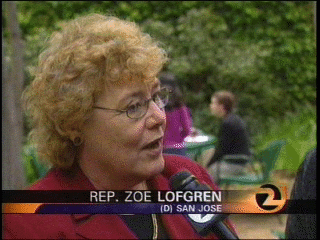
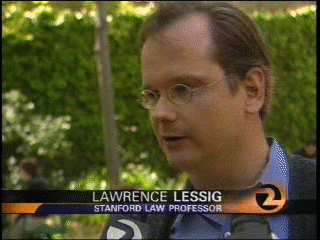
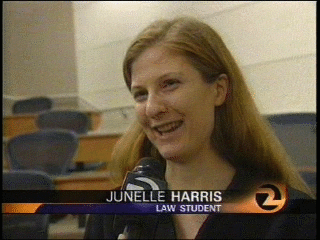
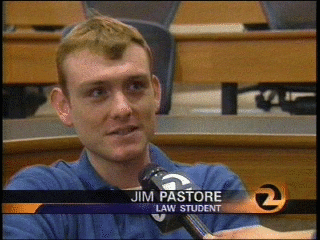
Okay so I won't hold up the rest of these clips waiting for the tour pages.
I've still got the rest of ETech to do, then I'm going back to my Spectrum Conference and SXSW 2003 footage.
Here's the Howard Rheingold Etech 2003 presentation. The tour page will go up in a day or so.
I've broken down some of these files for easier download over slower connections.
Howard Rheingold at Etech - Video in two parts:
Howard Rheingold at Etech Part 1 of 2 (Small - 30 MB)
Howard Rheingold at Etech Part 2 of 2 (Small - 50 MB)
Video in three parts:
Howard Rheingold at Etech Part 1 of 3 (Small - 40 MB)
Howard Rheingold at Etech Part 2 of 3 (Small - 40 MB)
Howard Rheingold at Etech Part 3 of 3 (Small - 30 MB)
Audio in two parts:
Audio - Howard Rheingold at Etech Part 1 of 2 (MP3 - 35 MB)
Audio - Howard Rheingold at Etech Part 2 of 2 (MP3 - 37 MB)
Audio in four parts:
Audio - Howard Rheingold at Etech Part 1 of 4 (MP3 - 20 MB)
Audio - Howard Rheingold at Etech Part 2 of 4 (MP3 - 20 MB)
Audio - Howard Rheingold at Etech Part 3 of 4 (MP3 - 16 MB)
Audio - Howard Rheingold at Etech Part 4 of 4 (MP3 - 17 MB)
Photos:
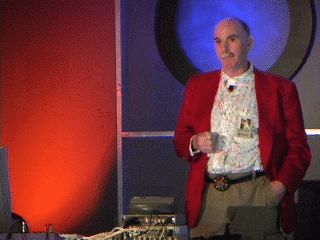


Confession time: I didn't even know who Alan Kay was until a week ago.
(Bio 1, Bio2.)
Now my mind is forever changed.
For this reason, it became important to me to preserve this presentation so that the information and wisdom it contains could be spread to a larger audience.
This page is still very much a work-in-progress, as there are still several names, dates and facts that need to be included. Please feel free to email me with any factoids and links that might serve to enrich the page.
Thanks!
Alan explains what his talk is going to be about: "...a little bit of complaining about where we are and what hasn't happened, pay tribute to a few things that were done a long time ago...(and) show you some ideas about how to make things better.." He also says that hopes to get the audience interested in Squeak so that he can enlist them in the project and that he will be previewing some alpha software at the end of his talk that he's really excited about.
(Note that this is a new link I've just put up for this at http://www.lisarein.com/alankay/tour.html -- there were some problems with the other link. Let me know that this is working ok guys!)
Lisa Rein's Tour Of Alan Kay's Etech 2003 Presentation

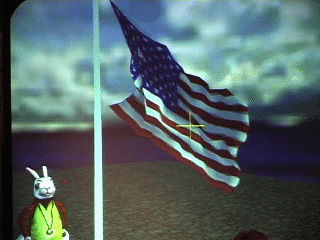
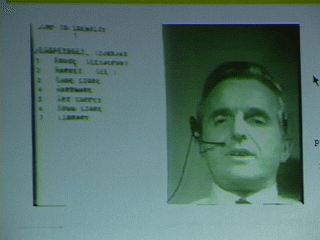
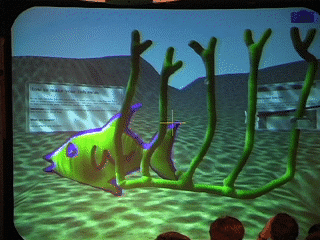
Many apologies for taking so long to get the Alan Kay presentation up.
I wanted to present all of the elements of Alan Kay's talk and presentation -- as exhibits in my library, if you will.
I've been pondering the different possibilities for some time. How should I organize my library for those who prefer to browse through history, rather than have it flung at them in numerous lengths and file formats.
So, with this presentation, I bring to you the advent of my "tour" pages. Pages that I hope to place in every directory of my Internet Archive Library that will provide you with a little more information about what's on the page, as well as the licensing info and any other relevant information for those works, as more information is made available to me.